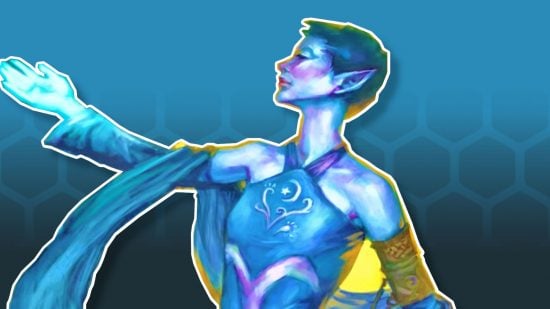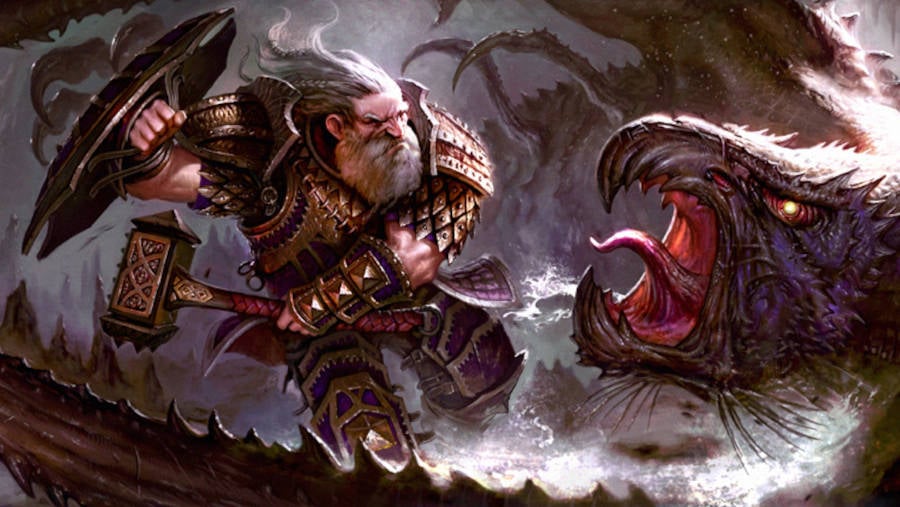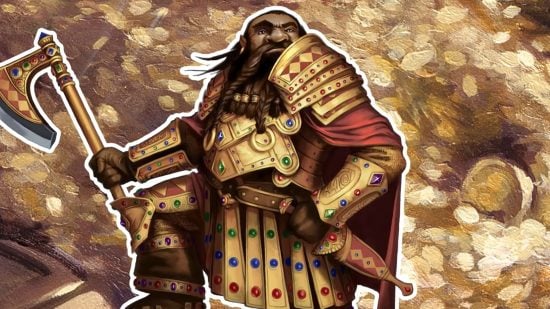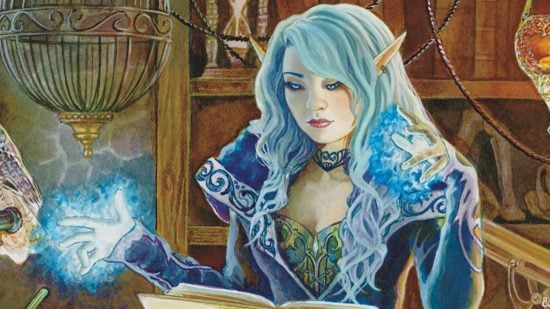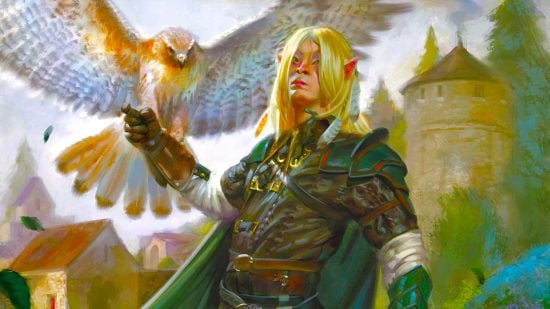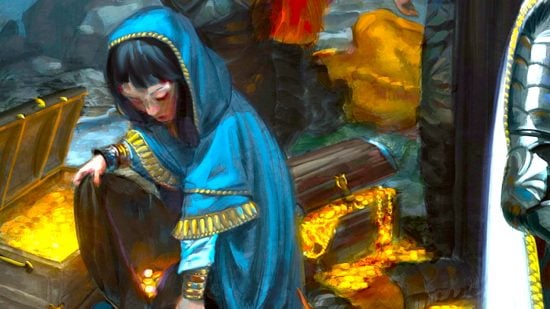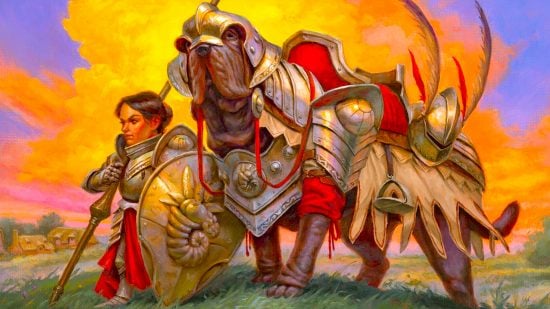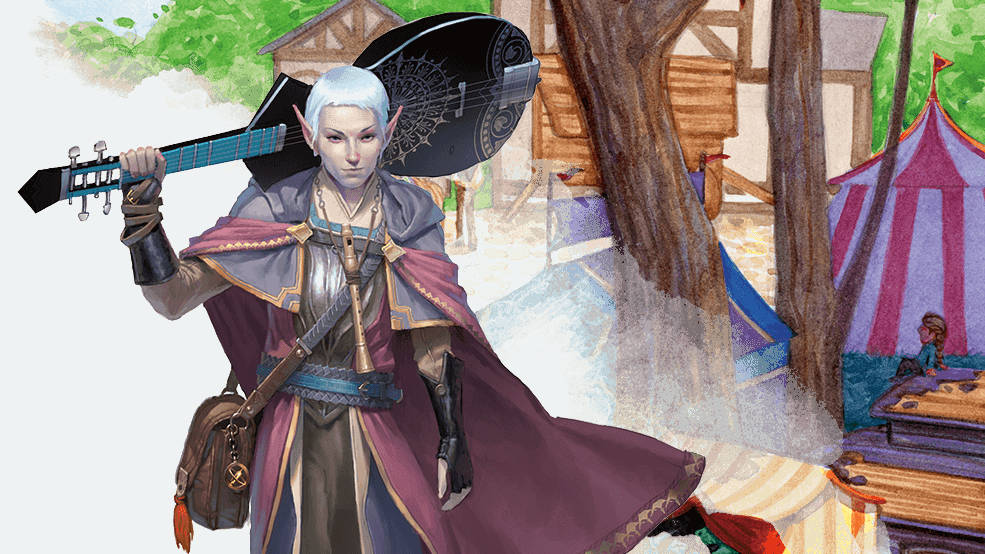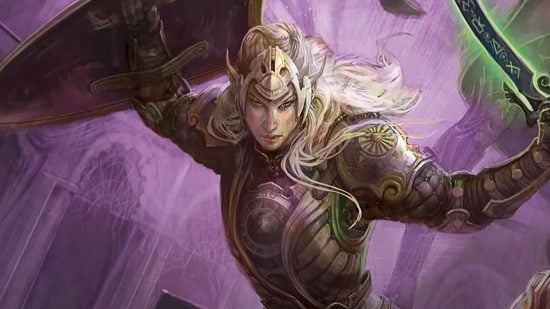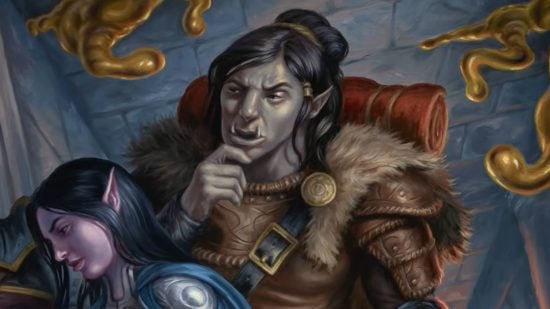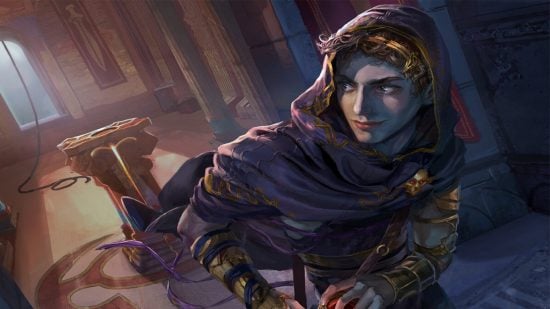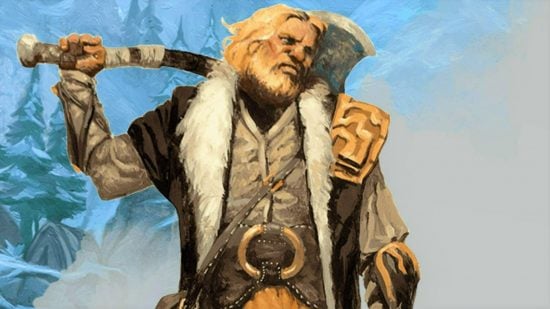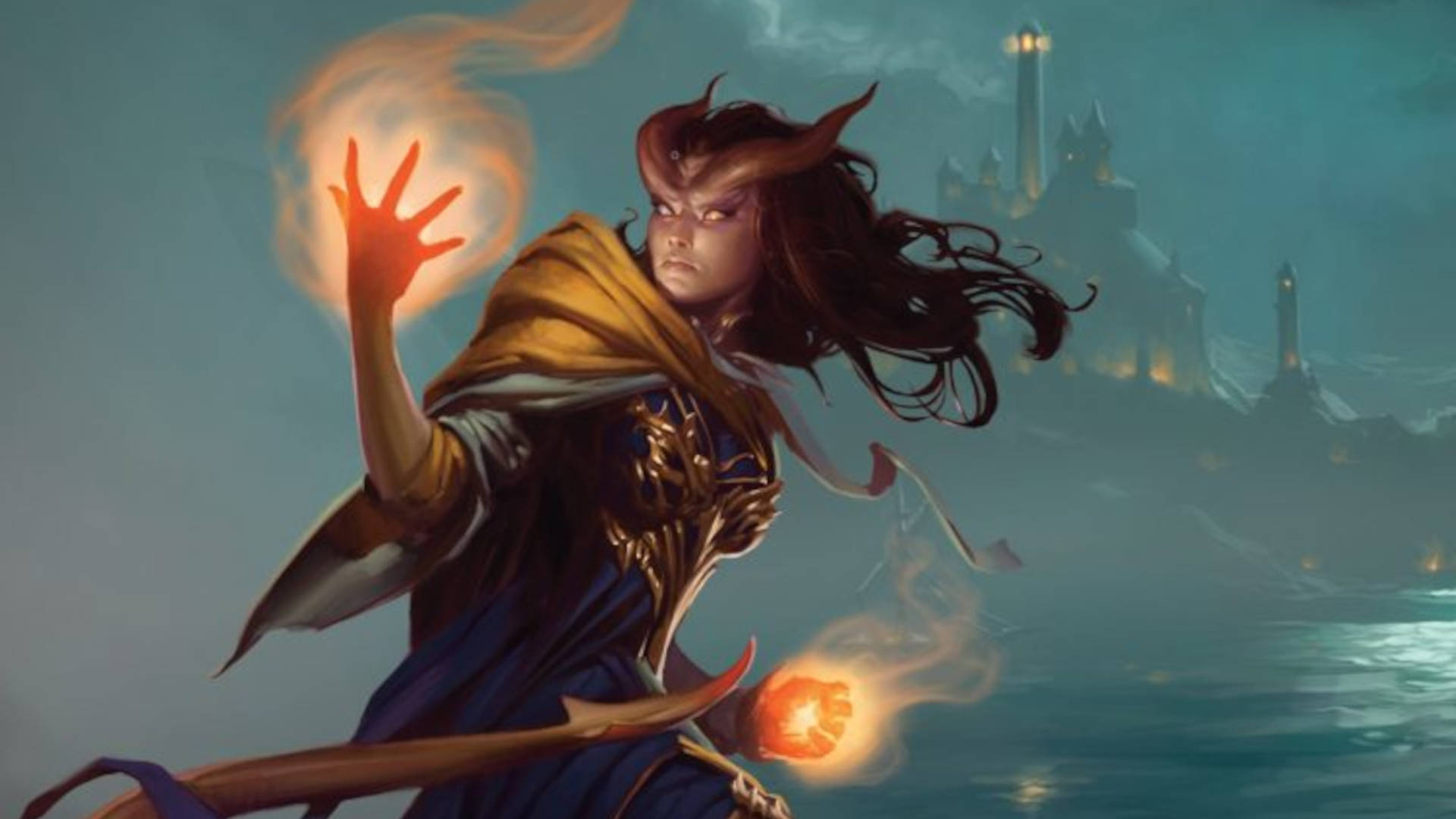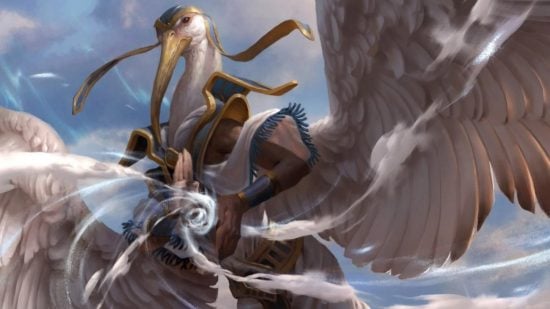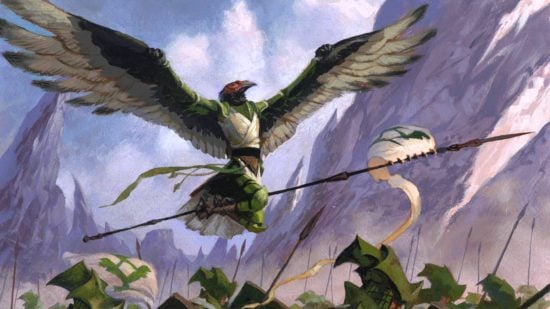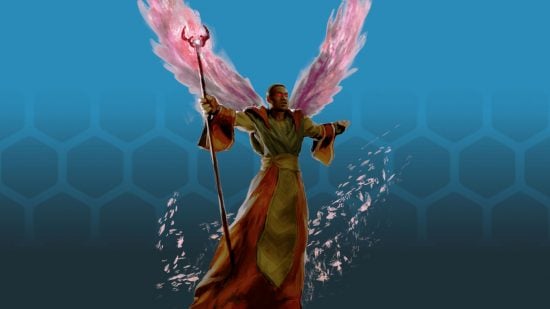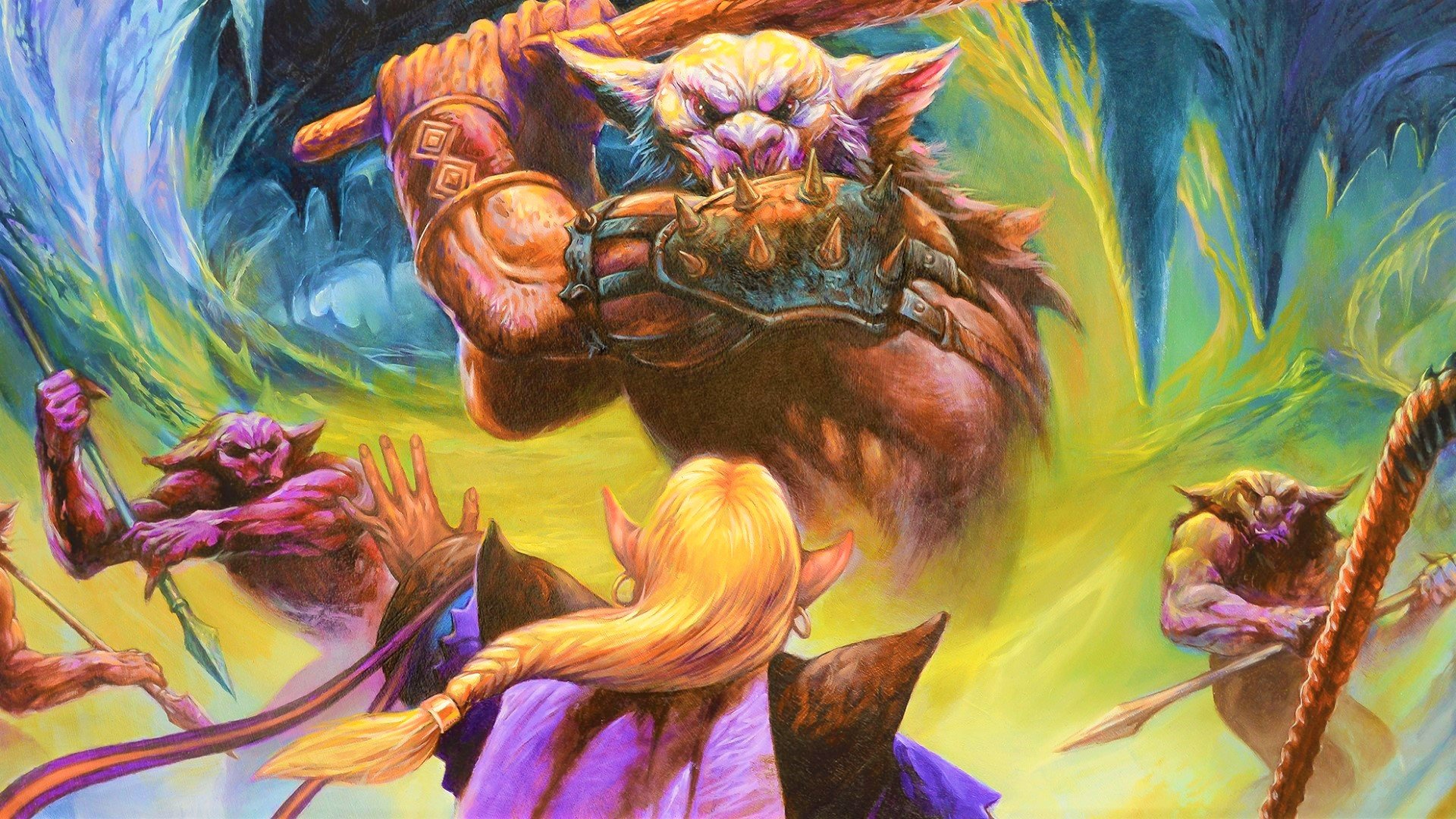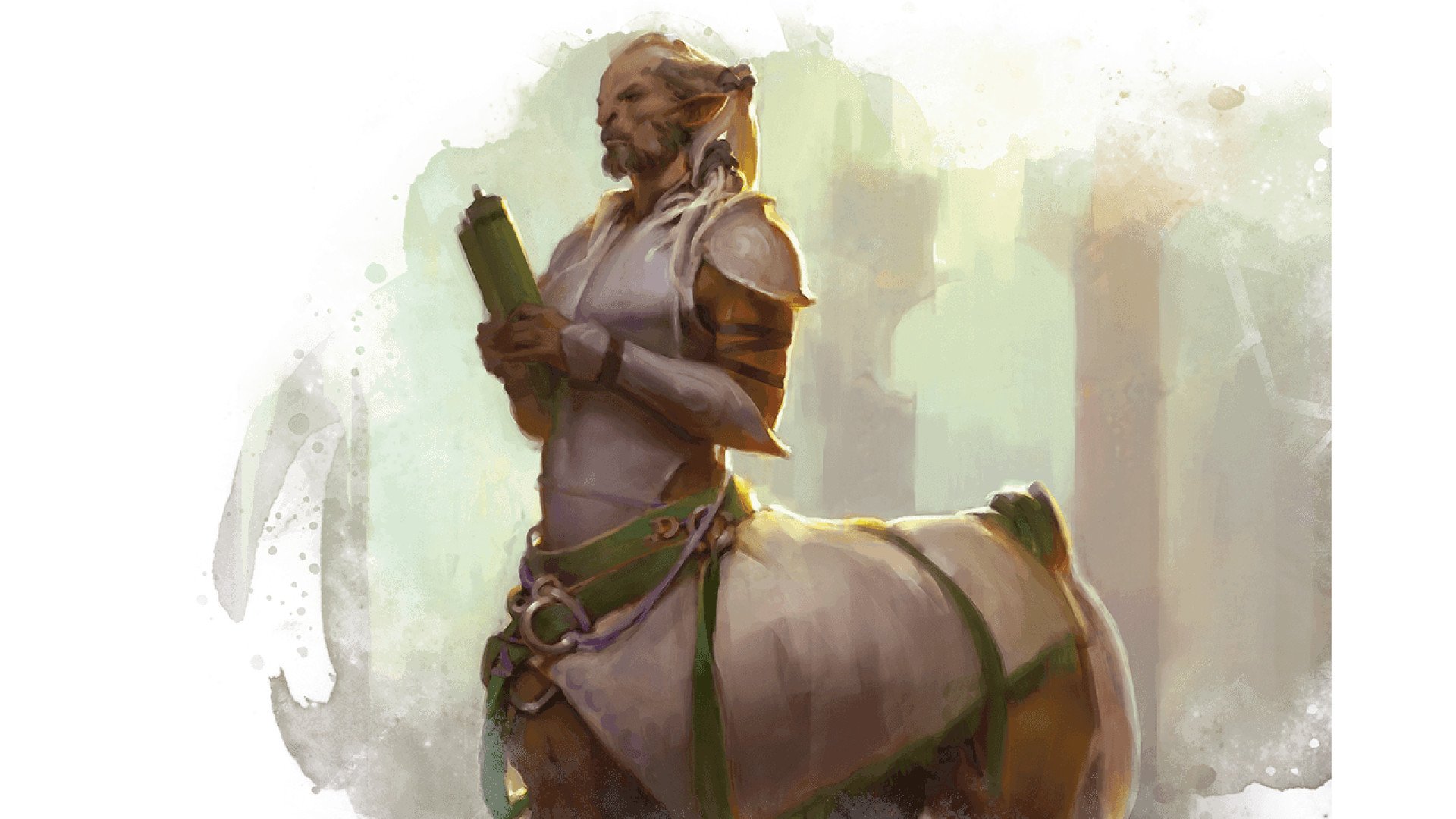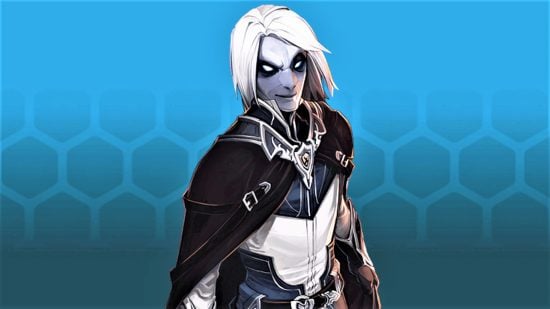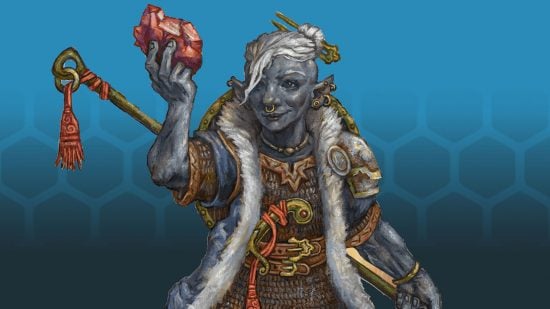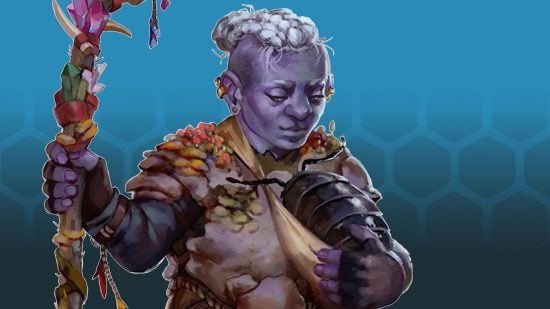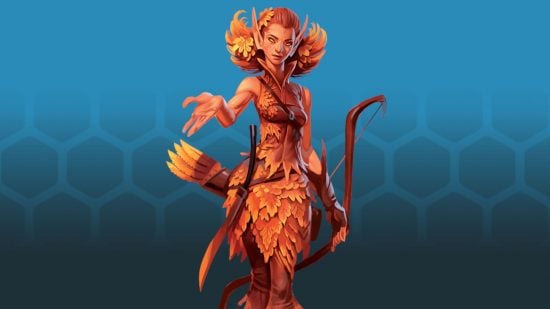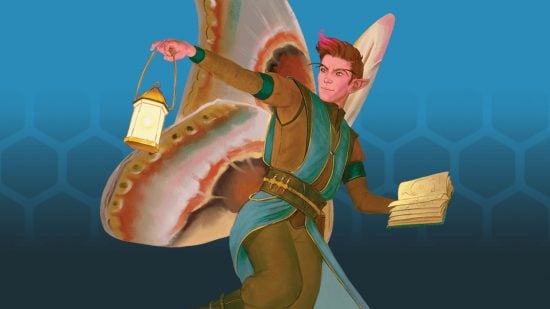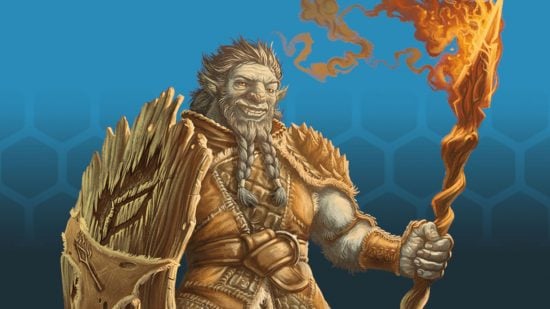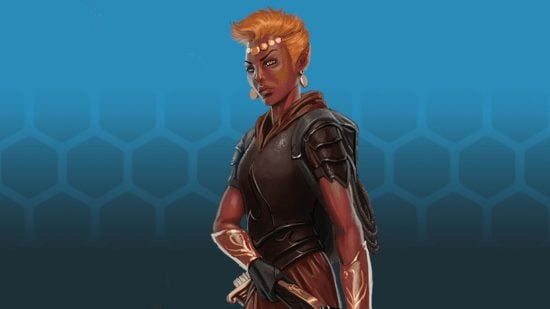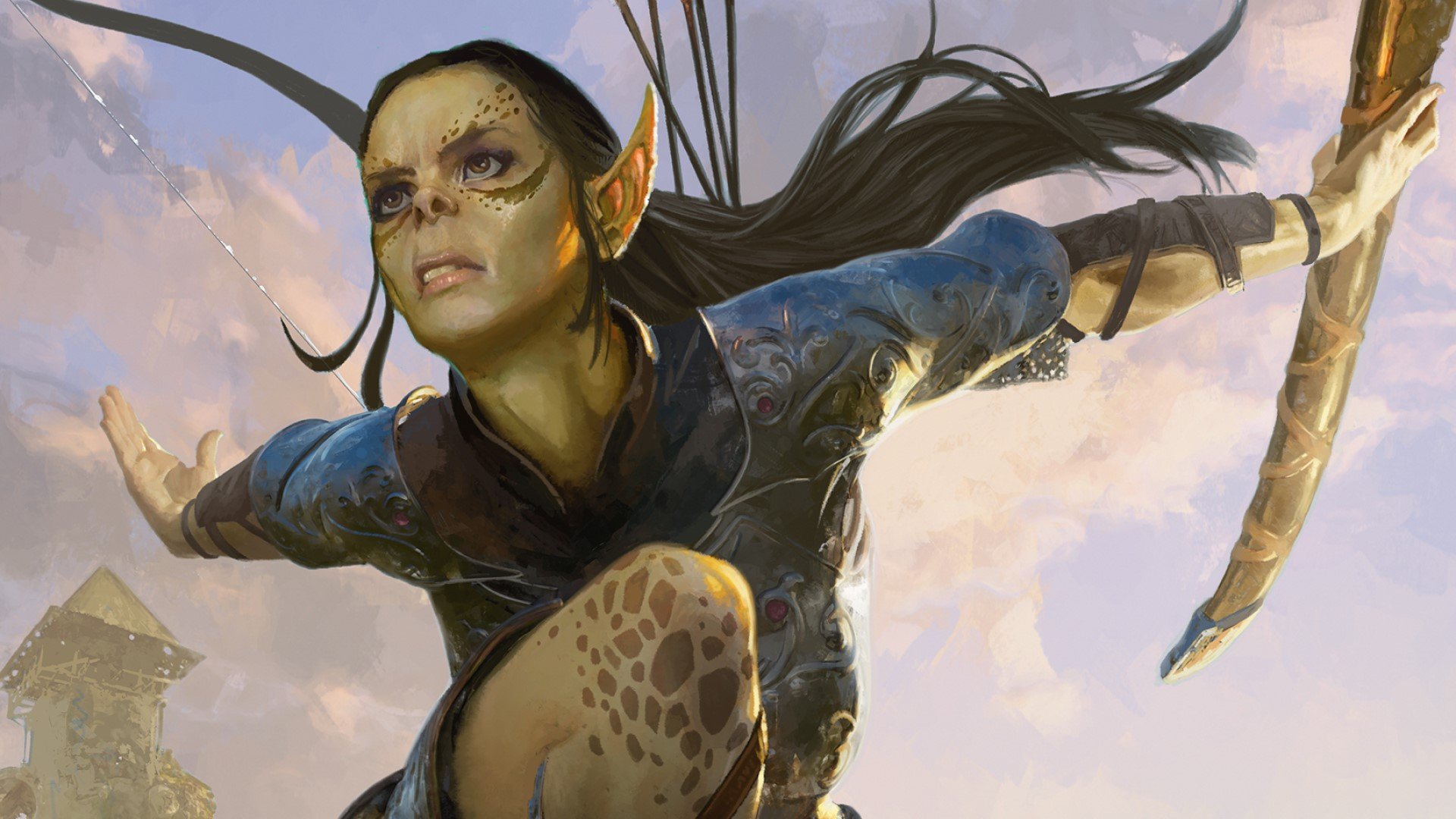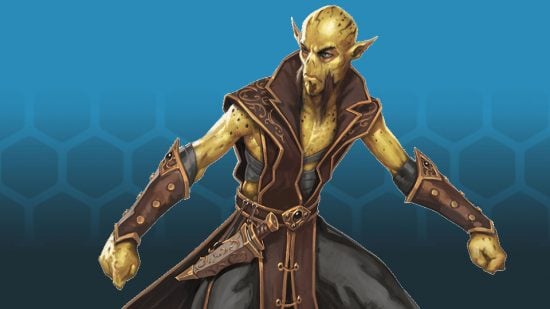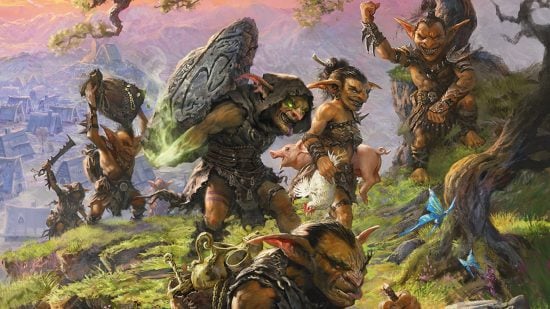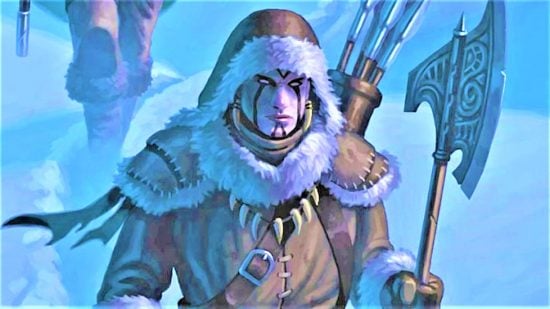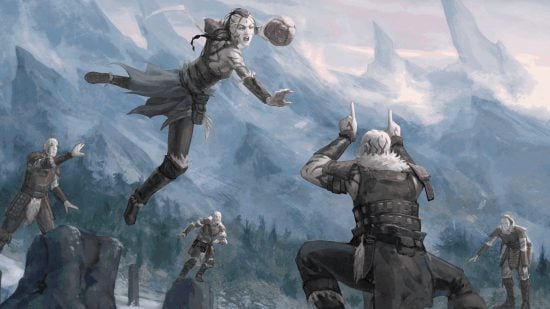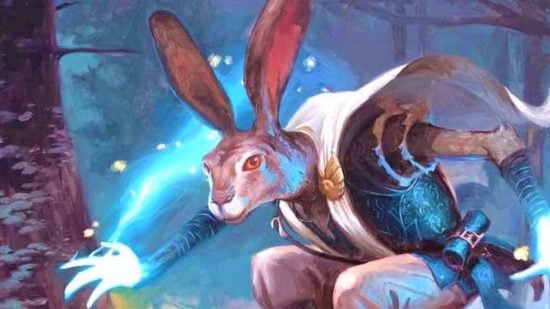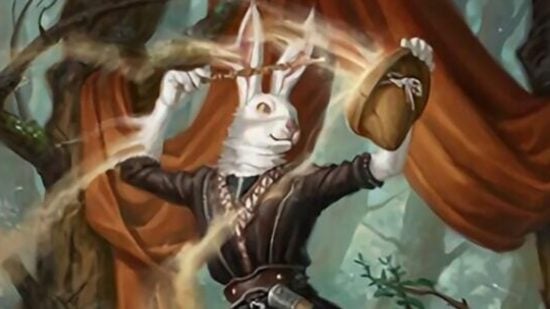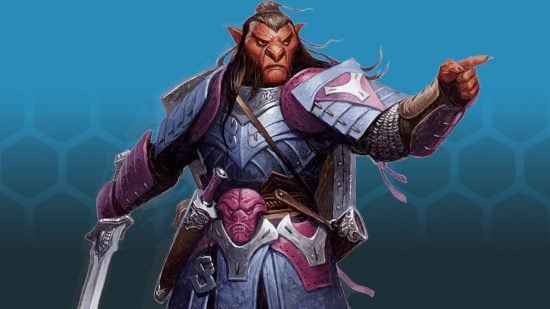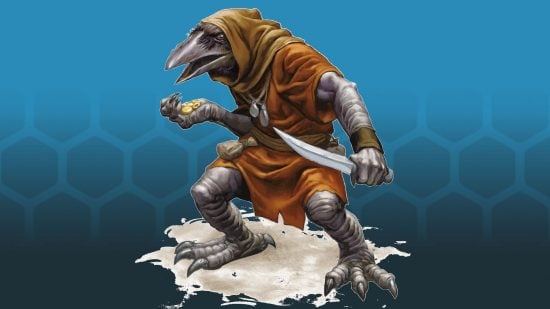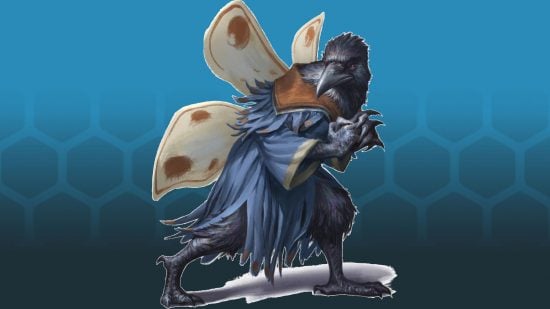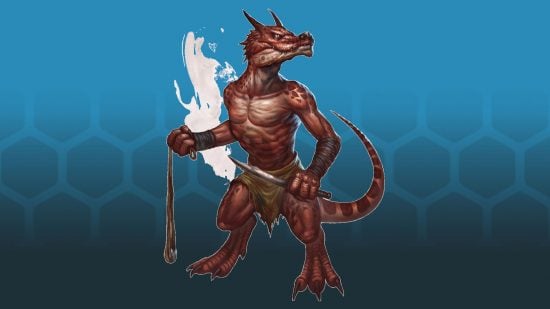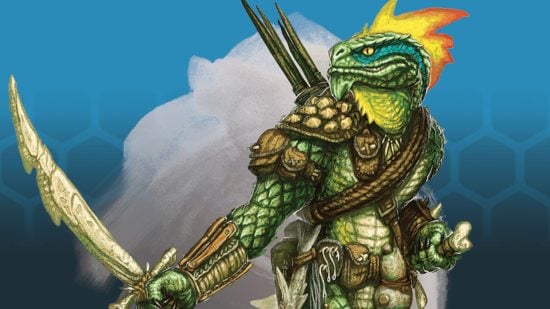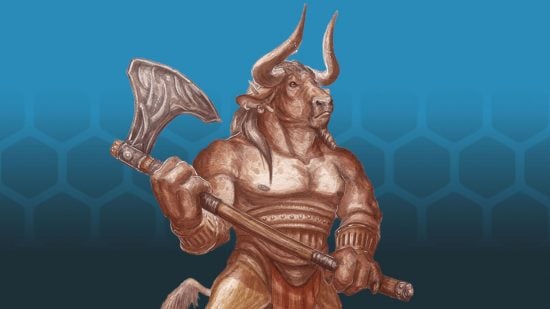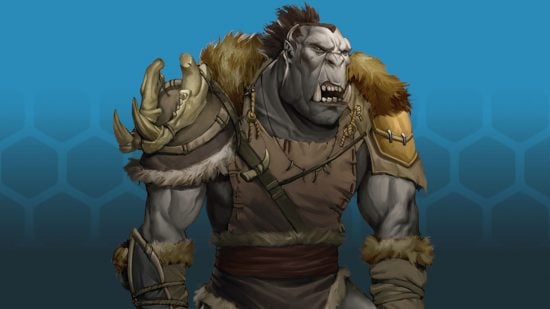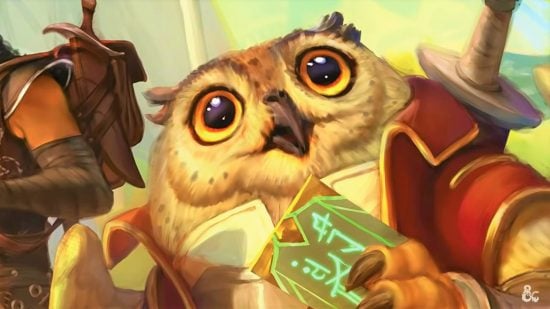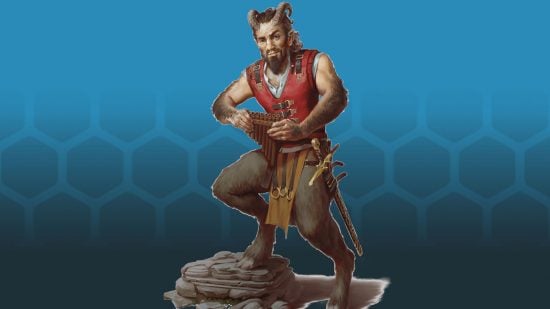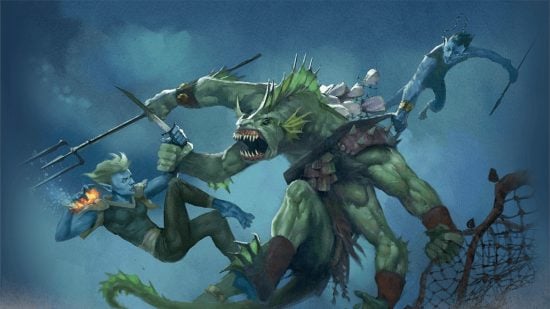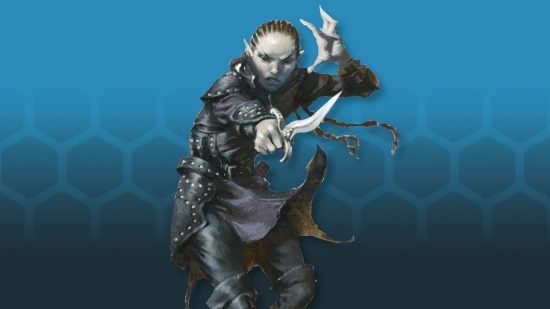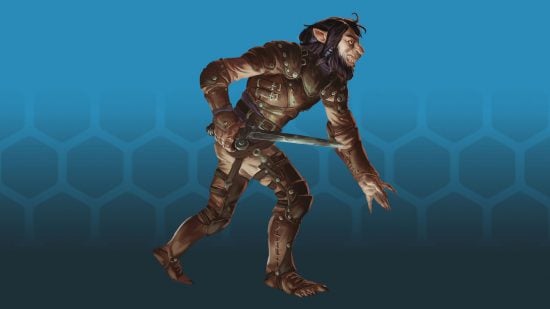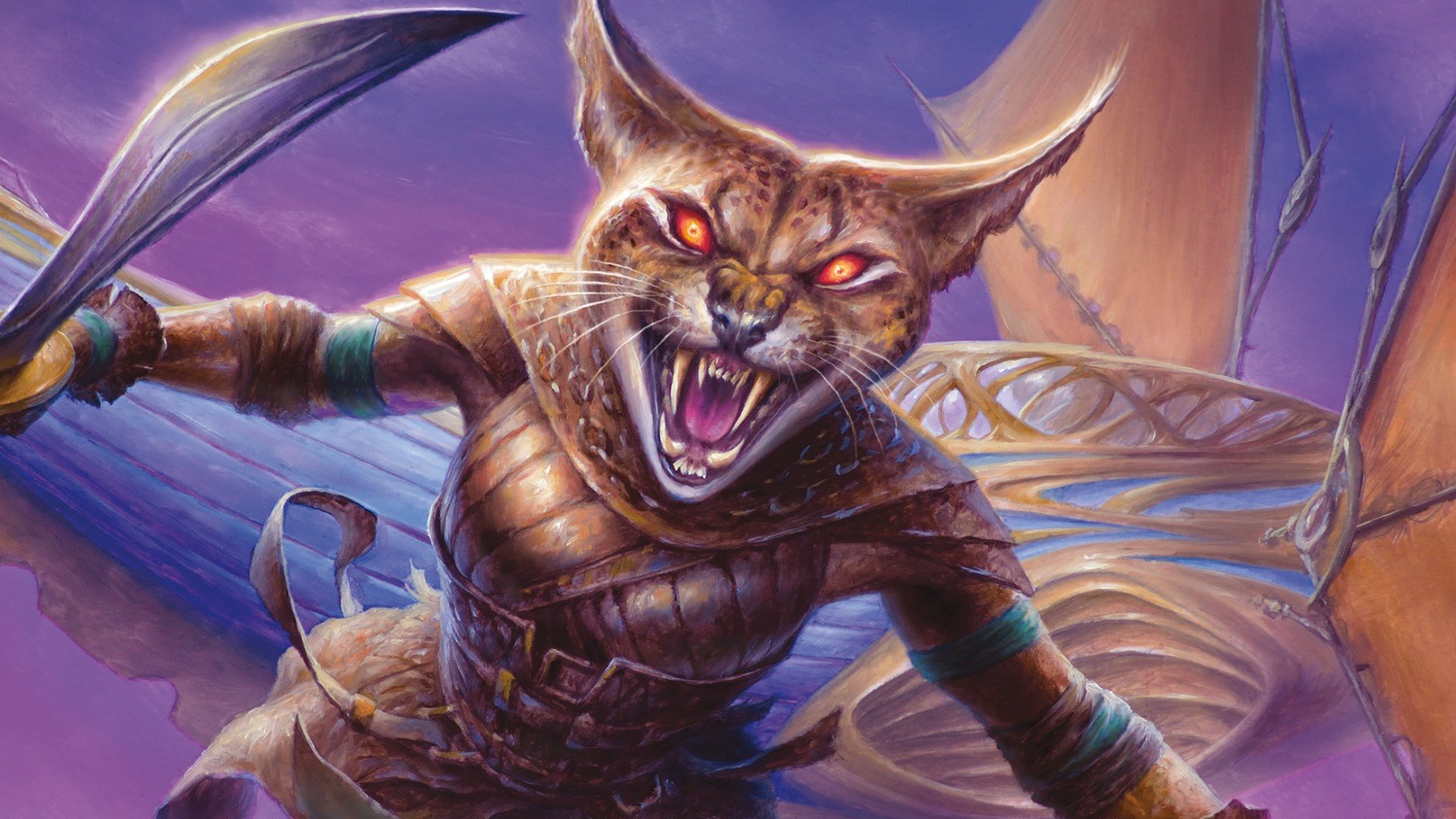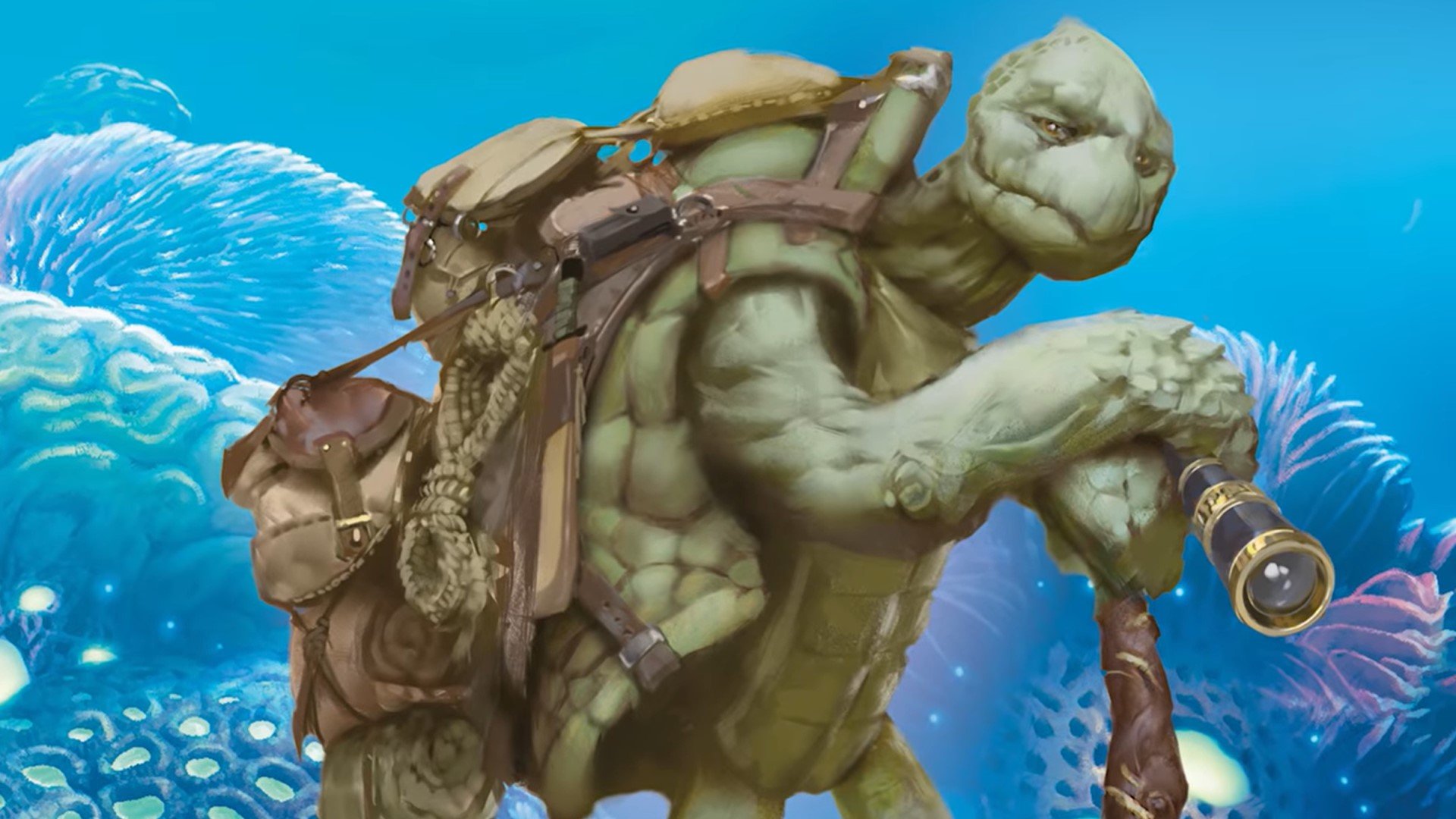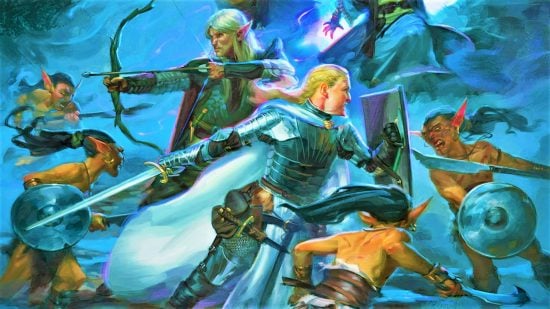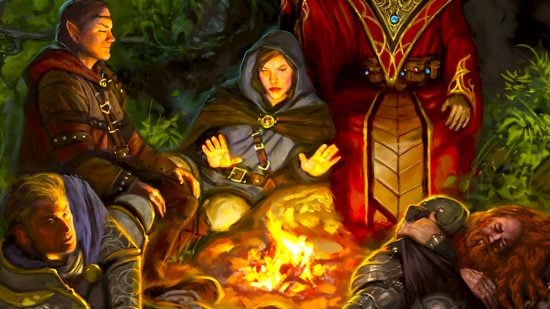Wizards of the Coast’s Dungeons and Dragons fantasy universe spans an impressive array of fantastical DnD races (or species, as they’re now being called). Some conform to familiar fantasy tropes, while others are unique, with few comparisons outside of D&D books. This guide profiles all the ‘common’ D&D races from the Player’s Handbook – plus many extras added in supplements over the years – pointing out their disparities and highlighting their gameplay differences.
After choosing your DnD classes, picking a race is the most important decision you’ll make during character creation. Aside from their appearances, each of the 5e races boasts unique traits that can greatly influence your character’s DnD skills, capabilities, and team roles. Some races have different DnD sizes, too.
To round out your character, we’d also recommend our guides to DnD backgrounds, the best DnD character sheets to use, and the best free DnD character creator tools online.
These are the core Dungeons & Dragons races:
- Dragonborn
- Dwarf 5e
- DnD Elf
- Gnome 5e
- Halfling 5e
- Half-Elf 5e
- Half-Orc 5e
- Human 5e
- Tiefling
For a quick summary of these DnD races, check out the official video below. But, for a more in-depth look at each species, read on!

For more options, here are the additional, fantastical Dungeons and Dragons races:
- Aarakocra
- Aasimar 5e
- Astral Elf 5e
- Autognome 5e
- Bugbear 5e
- Centaur 5e
- Changeling 5e
- Deep Gnome 5e
- Duergar 5e
- Eladrin 5e
- Fairy 5e
- Firbolg 5e
- Genasi
- Giff 5e
- Githyanki
- Githzerai
- Goblin 5e
- Goliath 5e
- Hadozee 5e
- Harengon
- Hobgoblin 5e
- Kalashtar 5e
- Kender 5e
- Kenku 5e
- Kobold
- Leonin 5e
- Lizardfolk 5e
- Minotaur 5e
- Orc 5e
- Owlin 5e
- Plasmoid 5e
- Satyr 5e
- Sea Elf 5e
- Shadar-kai 5e
- Shifter 5e
- Tabaxi
- Thri-kreen 5e
- Tortle 5e
- Triton 5e
- Warforged 5e
- Yuan-ti 5e
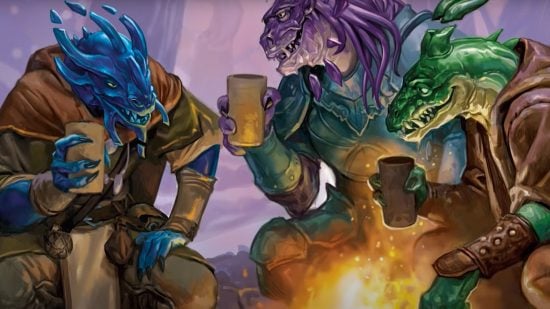
Dragonborn
Shiny scales and fiery breath.
| Ability scores | +2 Str, +1 Cha |
| Traits | Breath Weapon, Damage Resistance |
| Subraces | Draconic Ancestry |
| Suggested classes | Paladin, Barbarian, Warlock |
| Size | Medium |
| Speed | 30ft |
Humanoid dragons, the Dragonborn are an aged race split into devoted clans. Imbued with the blood of dragons, they aren’t commonly seen across the worlds of D&D, and are generally forthright, holding the honor of their clan in high esteem.
Their +2 Str and +1 Cha make a nicely balanced ability score range, but it’s their natural Breath Weapon that makes the Dragonborn stand out. Able to exhale a force of destructive energy that deals 2d6 damage on a failed Constitution saving throw, they’ve got an ace in the hole straight out of the gate.
Its damage and difficulty class will increase as you level, and your chosen Draconic Ancestry will determine its damage type, as well as your character’s resistances.
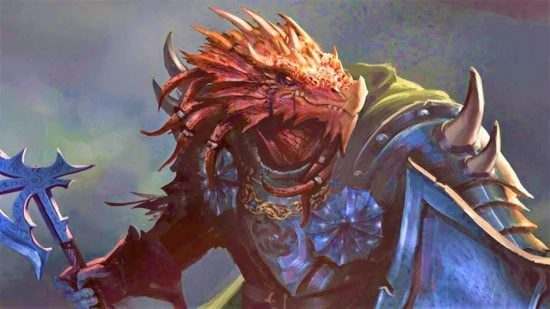
When picking a class, choose any that leverages Str or Cha. Barbarian is a good choice if you fancy rushing into the heat of battle, wielding a big ax, and crushing skulls.
Equally, The Charisma-focused spellcasting of Warlocks is well suited to Dragonborn, and their Breath Weapon provides a nice compliment to the class’s limited spell slots. But if you want to leverage both ability specialties, Paladin is the way to go: you’ll be dishing out high melee damage while channeling your deity’s magic.
Good news! We have even more to tell you about the Dragonborn 5e species in our full guide.
Dwarf 5e
Classic, compact, and Cleric-friendly.
| Ability scores | +2 Con |
| Traits | Darkvision, Dwarven Resilience, Dwarven Combat, Training, Stonecutting |
| Subraces | Hill Dwarf, Mountain Dwarf |
| Suggested classes | Cleric, Fighter, Barbarian, Druid |
| Size | Medium |
| Speed | 25ft |
D&D Dwarf 5e characters, in the main, closely match their traditional, Tolkien-esque representation across modern fantasy media. Stout cave dwellers, with a penchant for gold and all things shiny, they live long but can be slow to form amicable bonds with non-dwarven folk. Tending to stick within their clan, they’re hardy folk that rarely loosen their grip on a grudge.
On the tabletop, the DnD Dwarf race is one of the most durable character species options. Their natural +2 Con provides a lovely HP boost, and their Dwarven Resilience ability (granting resistance against poison damage) will prove useful time and again. Similarly, Hill Dwarves’ +1 HP per level, and Mountain Dwarves’ proficiency with light and medium armor, help withstand blow after blow.
When it comes to classes, Dwarves pair nicely with several options. The +2 Str of the Mountain Dwarf suits them to martial builds, such as the Barbarian or Fighter 5e, while the +2 Wis of Hill Dwarves makes them a great option for the Cleric 5e and Druid.
Ultimately, their toughness provides a malleability, and Dwarves can appropriately be built for any class, bar Bard 5e, Warlock 5e, and Sorcerer 5e, which rely on high Cha.
Learn more about this deep-delving DnD species by mining our dedicated Dwarf 5e guide.
DnD Elf
Agile and elegant, with added pointy ears.
| Ability scores | +2 Dex |
| Traits | Darkvision, Keen Senses, Fey Ancestry |
| Subraces | High Elf, Wood Elf, Dark Elf |
| Suggested classes | Rogue, Ranger, Wizard, Warlock |
| Size | Medium |
| Speed | 30ft |
Tall, sleek, and pointy-eared, The DnD Elf is a graceful being, most at home in ethereal forests and magical realms. Generally presented as virtuous beings that love all the good things in life (art, poetry, music), they’re often carefree spirits that are just as likely to show skill with a sword as they are with a spellbook.
Elves’ +2 Dex makes them perfectly suited to the sly and speedy activities of a Rogue or Ranger, while their natural proficiency in Perception, combined with Darkvision, accustoms them to stealth. Their Fey Ancestry, granting saving throws against being charmed and preventing them from being put to sleep, also comes in handy against manipulative foes.
But their subraces make them a suitable pick for virtually any class. Wood Elves, with their +1 Wis and already high Dex, make effective Monks, and are an obvious choice for the nature-loving, spellcasting Druid. Similarly, a High Elf Wizard has become a staple.
The +1 Int supports spellcasting, while proficiency with bows lets you keep your frail Wizard body out of harm’s way. The Cha-focused Drow (or Dark Elf) make effective Warlocks, given their race-based DnD cantrips circumvent the problem of limited spell slots.
Our complete DnD Elf 5e guide can tell you even more about this species.
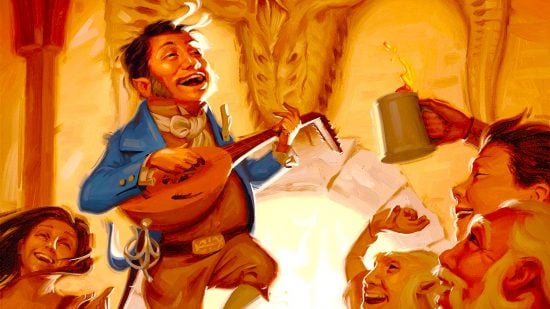
Gnome 5e
A small but cunning DnD race.
| Ability scores | +2 Int |
| Traits | Small, Darkvision, Gnome Cunning |
| Subraces | Forest Gnome, Rock Gnome |
| Suggested classes | Wizard, Rogue |
| Size | Small |
| Speed | 25ft |
Vibrant and expressive, DnD Gnomes are the game’s happiest race. Living within small burrows in forests and hillsides, they’re often styled as a curious race that enjoys the thrill of adventure, and the prospect of a reward. Not cave-loving Dwarves, nor pastoral Halflings, the Gnome 5e race is more similar to the fairies of folklore.
When it comes to adventuring, they’re astute and cunning, with +2 Intelligence and advantage on all Int, Wis, and Cha saving throws against magic. Alone, these aren’t hugely beneficial (especially compared with the Variant Human), but can be combined with the Gnome subraces for a few effective builds.
The Forest Gnome’s +1 Dex gives the opportunity to create a magically-inclined Rogue, and its Speak With Small Beasts trait is always fun to mess around with. The Rock Gnome’s +1 Con, on the other hand, makes it a great choice if you’re creating a classic Gnome Wizard, but want to add some muscles under their robes. Although their effective class options are few compared to other races, when Gnomes excel, they really excel.
We have a guide all about the Gnome 5e species for anyone who wants to play one.
Halfling 5e
Lucky and light on their feet.
| Ability scores | +2 Dex |
| Traits | Lucky, Brave, Nimbleness |
| Subraces | Lightfoot, Stout |
| Suggested classes | Rogue, Ranger, Bard |
| Size | Small |
| Speed | 25ft |
Halflings are small humanoids almost identical to the Hobbits of JRR Tolkien’s Middle-earth, though without thick foot hair and round front doors. Living in peaceful, bucolic communities usually hidden from the conflicts of the world, they’re cheerful and curious. Most comfortable in the wide outdoors, the Halfling 5e race usually has a strong grasp of tradition and a firm understanding of the importance of community.
Like Elves, Halflings’ +2 Dex makes them particularly adept Rogues and Rangers, while their small size lets them squeeze through tight spots, and move through any area occupied by a larger creature. But it’s their saving throws that really stand out. As well as possessing advantage against being frightened, their Lucky trait lets them reroll any ability check, saving throw, or attack roll that lands on a one, preventing catastrophes.
Halflings’ high Dex can be successfully paired with numerous classes. While stealthy builds are firm favorites, a Dex-based Fighter 5e can deal high ranged damage, and leap about the battlefield to evade enemies.
Be sure to pick a Stout Halfling for +1 Con, so you can really hold your own. The +1 Cha of Lightfoot Halflings makes them brilliant Bards, too, especially since their Lucky trait lets you reroll any daring, and probably ill-considered, roleplaying fumbles.
For a full description, check out our DnD Halfling 5e guide.
Half-Elf 5e
Dabble in a double life.
| Ability scores | +2 Cha, +1 any ability score |
| Traits | Darkvision, Fey Ancestry, Skill Versatility |
| Subraces | – |
| Suggested classes | Warlock, Sorcerer, Monk |
| Size | Medium |
| Speed | 30ft |
Born of Human and Elf parents, DnD Half-Elf characters take bits from both of their ancestral lines; sometimes the good, sometimes the bad. Fast outgrowing their slow-to-age Elf kin, and often more emotionally mature than their Human compadres, they’re often solitary beings, with no society to call home.
And their stats are equally divergent. With +2 Cha and +1 in two other abilities of your choice, the Half-Elf 5e race is flexible and suited to eclectic builds from the off. Add to that proficiency in two skills, Darkvision, and Fey Ancestry (preventing you from being put to sleep), and you have a powerful foundation to flexibly mold to whatever you envision.
Given this, Half-Elves pair nicely with any class. Their natural Cha, alongside a boost to Con and Dex, works brilliantly with a Warlock or Sorcerer, as you’ll be casting offensive 5e spells, without fear of retribution. Bard is the next obvious choice, with the two skill proficiencies expanding the class’s utility even further.
Plus, Monk, Ranger, or even Fighter can be good options. Although your Cha will be wasted in combat, Half-Elves’ breadth of ability scores and proficiencies makes for a versatile base.
Want to learn more? Here’s our full Half-Elf 5e species guide.
Half-Orc 5e
Mighty and sometimes fight-y.
| Ability scores | +2 Str, +1 Con |
| Traits | Darkvision, Menacing, Relentless Endurance, Savage Attacks |
| Subraces | – |
| Suggested classes | Barbarian, Fighter |
| Size | Medium |
| Speed | 30ft |
With Orc and Human blood running through their veins, Half-Orcs are D&D’s way of letting you play as the classic fantasy creature, and probably the most racially problematic player race in the game. Mixing natural Orcish strength and Human intelligence, they’re often rejected by other races, and live within Orc tribes.
Physical might is the calling card of the Half-Orc 5e. Boasting +2 Str and +1 Con, they’re best suited to axe-toting martial builds, in which they rush into the heart of a fight, swing wildly in all directions, and come away with only a few scratches to show for it.
Relentless Endurance, which gives them an extra one HP upon dropping to zero health, is useful insurance for reckless players (or new adventurers). Savage Attack, meanwhile, lets them roll an additional attack die whenever they land a critical hit – perfect for massive bursts of damage.
Barbarian Half-Orcs are the staple, given their ability scores and racial traits suit them perfectly to Barbarian’s rage-fueled, close-combat fighting. However, Half-Orcs also work nicely as Str-focused Fighters, having more opportunity to take the role of a tank within their party. Avoid any spellcasting class, but do consider a martial Paladin build, improving Cha as you level up.
Human 5e
Hey, it’s us!
| Ability scores | +1 in all ability scores (or +1 in two ability scores, one feat, and one skill proficiency) |
| Traits | – |
| Subraces | – |
| Suggested classes | Wizard, Cleric, Paladin |
| Size | Medium |
| Speed | 30ft |
This lot should be pretty familiar. DnD Human 5e characters are variable, versatile, and adaptable folks, who ambitiously explore the land for both personal gain and altruistic devotion. Their lives are short, and their empires enormous, built upon trade and war.
Humans are by far the most versatile of the common races, granting +1 to all ability scores. They also come in a second form – the Variant Human – providing +1 in only two ability scores, alongside a free feat and proficiency in one skill.
Given this is the only way to get a feat at first level, and doesn’t sacrifice an ability improvement, you’ll definitely want to use the Variant Human if you’re basing your character around 5e feats.
As for classes, Humans are highly malleable. Choosing two ability scores to focus on is particularly useful for classes that use spellcasting alongside martial attacks, such as battle Wizards, Clerics, or the Paladin 5e. But, really, you can use a Human for anything. They’re sticks of clay, ready to be molded into whatever form you choose.
For more info on our good friend the human, check out our full Human 5e guide.
Tiefling
Horns and hellfire.
| Ability scores | +2 Cha, +1 Int |
| Traits | Darkvision, Hellish Resistance, Infernal Legacy |
| Subraces | – |
| Suggested classes | Warlock, Sorcerer, Wizard |
| Size | Medium |
| Speed | 30ft |
Imbued with an infernal heritage, DnD Tiefling characters are best thought of as humans crossed with devils. Horns protrude from their forehead, a tail from their back, and sharp teeth fill their mouths. Often treated with suspicion, they usually gather in small communities, victim to the whispers and ignorance of others.
With +1 Int and +2 Cha, Tieflings aren’t the most diverse race, but they are well-suited to spellcasting and scrutinizing. Darkvision and resistance to fire damage keep them functioning in difficult combat encounters, while Infernal Legacy (granting them the ability to cast Hellish Rebuke at third level), provides an easy means of dealing 2d10 fire damage when you’re in a bind.
Their natural ability scores pair wonderfully with any Cha-focused class, such as Sorcerer or Bard, and Hellish Rebuke is particularly useful for spell slot-strapped Warlocks. If you’d prefer something a little more unusual, test out a tanky Paladin build, and focus on gaining feats for more damage resistance.
For anyone looking to play a Tiefling, we have a full, comprehensive Tiefling 5e species guide right here on Wargamer.
Aarakocra
Everyone wishes they could fly, don’t lie.
| Ability scores | +2 Dex, +1 Wis |
| Traits | Flight, Talons |
| Subraces | – |
| Suggested classes | Ranger, Rogue, Fighter |
| Size | Medium |
| Speed | 25ft (walking); 50ft (flying while not wearing medium or heavy armor) |
Anthropomorphic birds, Aarakocra are big, beaked, and come from beyond the Material Plane. Originating in the limitless Elemental Plane of Air, they feel most at home soaring through the open sky or displaying their avian mannerisms, whether that’s showing off their tribal plumage, interspersing their speech with lyrical chirps, or picking up shiny treasures to decorate their settlements.
The standout feature of Aarakocra is their Flight ability. With a large pair of feathered wings sprouting from their back, they were the first playable D&D race that could fly, letting them soar above enemies to pick them off from afar. They also sport a pair of talons that let you deal damage equal to 1d4 + your Str modifier damage, and get +2 Dex and +1 Wis.
Given their natural Dex increase, Aaarakocra can make a brilliant Ranger 5e, especially if paired with the Archery fighting style to make use of their mobility. The Rogue 5e is also a good choice, as Flight lets you hop about hiding places with even more ease.
If you want a more martial build, go for a Fighter specializing in Finesse weapons. Flight will help you traverse the battlefield.
For a full run-through of the best Aarakocra names, classes, and builds, check out our full Aarakocra 5e species guide.
Aasimar 5e
Bask in their celestial radiance.
| Ability scores | +2 and +1 two different stats, or +1 any three |
| Traits | Darkvision (60ft), Celestial Resistance, Healing Hands, Light Bearer, Celestial Revelation |
| Subraces | – |
| Classes | Cleric, Warlock, Paladin |
| Size | Medium or small |
| Speed | 30ft |
The Aasimar 5e is a mortal race, but some strange occurrence or inheritance has given them a slither of celestial power. They have many of the physical features of a creature from the Upper Planes, and they’re often gifted with the magic of radiant light, healing, and flight. Of course, they’re not limited to these angelic feats – plenty of Aasimar turn to more necromantic pursuits, too.
Celestial Resistance means all Aasimar are resistant to necrotic and radiant damage, and they can innately cast Light using their Charisma modifier. Healing Hands also gives an Aasimar a free healing ability – they can touch a creature and roll d4s equal to their proficiency modifier to restore that much HP.
And then there’s Celestial Revelation, which lets you unleash your true power. You get to choose what that celestial power is:
- Gaining flying speed equal to your walking speed and dealing radiant damage along with regular attack/spell damage.
- Giving creatures the frightened condition on a failed Charisma saving throw and dealing extra necrotic damage along with attack/spell damage.
- Dealing radiant damage with a ten-foot light, and then dealing extra radiant damage along with regular attack/spell damage.
Theme-wise, the DnD Paladin makes sense for an Aasimar – they’re holy smiters who make great use of their Charisma modifier. However, we think the DnD Cleric and DnD Warlock make even better choices. The Cleric will appreciate a free heal, and any squishy spellcaster will need options for dodging out of close combat.

Astral Elf 5e
ELVES. IN. SPAAAAAAAACE.
| Ability scores | +2 and +1 two different stats, or +1 any three |
| Traits | Astral Fire, Darkvision, Fey Ancestry, Keen Senses, Starlight Step, Astral Trance |
| Subraces | – |
| Suggested classes | Bard |
| Size | Medium |
| Speed | 30ft |
The Astral Elf 5e comes from the Astral Plane (and the Spelljammer: Adventures in Space sourcebook). They have many of the standard Elf’s abilities, including Darkvision, advantage on saving throws against being charmed, and the ability to go into a trance rather than sleep. Starlight Step also lets them teleport 30 feet as a bonus action, and they’re naturally proficient in Perception.
The Astral Trance is a bit different from the respite that other Elves get. Whenever you finish a trance, you gain proficiency with one skill and weapon/tool from the Player’s Handbook. You can switch these every time you take a DnD long rest – perfect for the party Skill Monkey.

Autognome 5e
Don’t just do the Robot, be the Robot.
| Ability scores | +2 and +1 two different stats, or +1 any three |
| Traits | Armored Casing, Built for Success, Healing Machine, Mechanical Nature, Sentry’s Rest, Specialized Design |
| Subraces | – |
| Suggested classes | All |
| Size | Small |
| Speed | 30ft |
The fifth edition Spelljammer books gave us the Autognome 5e, and these pint-sized automatons have a variety of abilities to offer. Thanks to your metal body, you have a base armor class of 13 + your Dexterity modifier, even without armor. And while you can benefit from a certain number of healing spells, your Construct creature type means you can spend a Hit Die any time someone casts Mending on you.
Built for Success lets you add a d4 to any attack roll, ability check, or saving throw you make, and you can use it multiple times per long rest. Sentry’s Rest means you can remain conscious during those rests, and Specialized Design grants you two extra tool proficiencies.
The Artificer is an obvious choice of class here, but the Autognome’s abilities are a great buff for pretty much everyone. Who doesn’t love a beefy armor class and the chance to boost any roll they like? Keep that Dex score high, and you’re golden.
Bugbear 5e
A classic monster turned player race.
| Ability scores | +1 and +2 any two, or +1 any three |
| Traits | Fey Ancestry, Long-Limbed, Powerful Build, Sneaky, Surprise Attack |
| Subraces | – |
| Classes | Barbarian, Monk, Warlock |
| Size | Medium |
| Speed | 30ft |
Once one of the most recognizable DnD monsters, members of the Bugbear 5e race can also be a playable character. They’re the hairy, stocky cousins of goblins, and they’ve a little bit of Feywild magic to help them with skills like stealth.
This isn’t a race with spellcasting abilities, though; Fey Ancestry simply gives Bugbears advantage on saving throws against being charmed. They are Sneaky, though. As well as being proficient in stealth, they can deal a Surprise Attack (and an extra 2d6 damage) to any creature that hasn’t taken a turn yet in combat.
While a Rogue might seem like an obvious choice for a Bugbear, that Surprise Attack is useful for pretty much any class that wants to be useful in combat. We recommend building a Bugbear Barbarian or Monk – or, if you prefer magical damage to melee, a Bugbear Warlock is also a solid choice.
For full details on how you can become a big ol’ Bugbear, check out our complete Bugbear 5e species guide.
Centuar 5e
Mythology made real.
| Ability scores | +2 and +1 two different stats, or +1 any three |
| Traits | Equine Build, Hooves, Natural Affinity |
| Subraces | – |
| Classes | Barbarian, Fighter |
| Size | Medium |
| Speed | 40ft |
If you’re a lover of Greek mythology (or just horses in general), consider playing the Centaur 5e race. These half-humanoid, half-horse Fey creatures have an affinity with nature – and a powerful hind kick.
As a Centaur, you’ll often be charging into battle – literally. Charge lets you storm 30ft into melee range, hit with your weapons, and then get a Hooves attack with your bonus action. Your hooves are pretty hefty, dealing 1d6 plus your Strength modifier as an unarmed attack.
Centaurs can also choose a proficiency in Animal Handling, Nature, Medicine, or Survival thanks to their Fey ties. They’ve got a superior carrying capacity to other creatures of their size, but please don’t ask them to climb anything. The hooves make it very difficult.
While there are multiple sourcebooks you could use to build a Centaur character, one thing remains consistent: this race plays best with frontline martial characters. Your Hooves attack relies on having a high Strength modifier, and the Charge feature allows you to attack with your hooves as a bonus action after running into melee combat. This means the Barbarian and the Fighter are the optimum class choices.
Changeling 5e
Alter your appearance at will.
| Ability scores | +2 and +1 two different stats, or +1 any three |
| Traits | Changeling Instincts, Shapechanger |
| Subraces | – |
| Classes | Rogue, Bard |
| Size | Medium or small |
| Speed | 30ft |
The Changeling 5e has the power to completely change their appearance, shifting to appear as someone else. Their Shapechanger ability works a little like Disguise Self – only with guaranteed success. As an action, the Changeling can transform (visually at least) into a person of any gender or race that they’ve seen before.
Changelings are also naturally adept in social situations. Changeling Instincts lets you pick two proficiencies from the following:
- Deception
- Insight
- Intimidation
- Performance
- Persuasion
Their mastery of disguise, extra proficiencies, and preference for Charisma-based skills makes the Changeling ideal for two classes in particular: the sneaky Rogue and the performative Bard.
Deep Gnome 5e
Gnomes who spent a lot of time in the dark.
| Ability scores | +2 and +1 two different stats, or +1 any three |
| Traits | Gift of the Svirfneblin, Gnomish Magic Resistance, Svirfneblin Camouflage |
| Subraces | – |
| Classes | Ranger, Rogue |
| Size | Small |
| Speed | 30ft |
While they were once a subrace of the core Gnome species, there’s now a complete Deep Gnome 5e race. Now separated from their surface-dwelling siblings, Deep Gnomes use the custom origin stats of all races in Monsters of the Multiverse.
Gift of the Svirfneblin allows a Deep Gnome to cast Disguise Self from level three and Nondetection from level five. Deep Gnomes gain advantage on Intelligence, Wisdom, and Charisma saving throws against spells thanks to their Gnomish Magic Resistance. Plus, Svirfneblin Camouflage gives them advantage on Stealth checks a certain number of times per long rest.
The Deep Gnome’s features complement almost any class in D&D. We’d recommend playing whichever strikes your fancy – though, if you’re looking to optimize at every possible turn, we’d recommend the Ranger and the Rogue. These classes are naturally a bit more agile and more likely to use the Deep Gnome’s stealth benefits.
Duergar 5e
A Dwarf that’s really deep.
| Ability scores | +2 and +1 two different stats, or +1 any three |
| Traits | Darkvision, Duergar Magic, Dwarven Resilience, Psionic Fortitude |
| Subraces | – |
| Classes | Ranger, Paladin |
| Size | Medium |
| Speed | 30ft |
Like the Deep Gnome, the Duergar 5e is both a race and a subrace. It was the DnD book Monsters of the Multiverse that turned these dwarves into their own separate species.
Many of the Duergar’s racial features remain (though with a few quality-of-life tweaks). They still have Dwarven Resilience, which gives them resistance to poison damage and advantage on saving throws against poison. They also still have 120ft of Darkvision and the ability to cast Invisibility and Enlarge/Reduce using their Duergar Magic.
The Duergar’s sunlight sensitivity is (thankfully) gone, so they’re not disadvantaged when adventuring during the day. They also have advantage on saving throws against being charmed or stunned.
While flexible stats mean a Duergar is playable for pretty much any class, those that use magic to enhance their combat and stealth skills will maximize the Duergar’s potential. We suggest the Ranger and Paladin as the optimal choices.
Eladrin 5e
A character for all seasons.
| Ability scores | +1 and +2 any two, or +1 any three ability scores |
| Traits | Darkvision, Fey Ancestry, Fey Step, Keen Senses, Trance |
| Subraces | – |
| Suggested classes | Druid, Cleric |
| Size | Medium |
| Speed | 30ft |
The Eladrin 5e are Elves that specifically come from the Feywild. They’re best-known for their tie to the seasons that define the Fey Courts. An Eladrin might change seasons over their life or always remain the same -this detail can be up to you.
As well as advantage on saving throws against the charmed condition, an Eladrin can teleport 30ft as a bonus action and immediately gain a particular benefit granted by their season. (We’re particularly keen on Spring, which lets you teleport another creature instead of yourself.) Eladrin also have proficiency in Perception, and they can enter a chance instead of sleeping, finishing a long rest in just four hours.
Being able to teleport is an excellent ability for any character that can’t do so already. Since Eladrin also have a natural lean towards Wisdom-based skills, we recommend playing a Druid or Cleric. However, thanks to their custom ability skills, an Eladrin is suitable for any class you like.
Fairy 5e
I do believe in fairies, I do.
| Ability scores | +1 and +2 any two, or +1 any three ability scores |
| Traits | Fairy Magic, Flight |
| Subraces | – |
| Suggested classes | Rogue, Druid |
| Size | Small |
| Speed | 30ft |
When people think of a Fey creature, a Fairy 5e usually comes to mind first. Agile, mystical, and tricksy, these creatures are gifted with additional spellcasting and the ability to take to the skies any time they like, with a flying speed equal to their walking speed.
Specifically, Fairy Magic means you automatically know the Druidcraft cantrip. Once you reach level three, you’ll be able to cast Faerie Fire, and then you’ll pick up Enlarge / Reduce at level five. Both spells can only be cast once per long rest.
You can choose whether Wisdom, Intelligence, or Charisma as your spellcasting modifier for these extra spells. Because of this and their flexible ability score increases, Fairies make a suitable species for just about any class. We’d recommend one that’ll really benefit from flight – like the agile Rogue or a Druid armed with ranged area-of-effect spells.
Firbolg 5e
Not quite a Giant, but almost.
| Ability scores | +1 and +2 any two, or +1 any three ability scores |
| Traits | Firbolg Magic, Hidden Step, Powerful Build, Speech of Beast and Leaf |
| Subraces | – |
| Suggested classes | Rogue |
| Size | Medium |
| Speed | 30ft |
The Firbolg 5e is a distant relation of the Giants. Despite this, there’s not much about them that’s particularly Giant-y. They may bear some physical resemblance to their ancestors (and they do count as a size larger when determining how much they can push, drag, lift, or carry), but they’re the same size as most other humanoids. And they seem to have more expertise in magic rather than brute strength.
This isn’t too much of a surprise – plenty of Giants are magical in the world of D&D. But Firbolg Magic is tied to the race’s affinity for sneaking about in forests.
They innately know how to Detect Magic 5e and Disguise Self, with fewer restrictions than the average spellcaster. As a bonus action, a Firbolg can turn invisible until their next turn or attack begins. And their ties to the woods mean they have limited influence over beasts, plants, and other vegetation.
While all this forest flavor may draw you to the Druid or Ranger classes, we argue that the Rogue is a far better option for Firbolg players. Invisibility, disguises, and advantage on beast-based Charisma checks all play into what a Rogue does best. You can expand the magical capabilities of your Arcane Trickster, or you can grant some magical benefits to any of the other Rogue subclasses 5e.
Genasi
Channel the power of the elements.
| Ability scores | +1 and +2 any two, or +1 any three ability scores |
| Traits | Dependent on subrace |
| Subraces | Air, Earth, Fire, and Water |
| Suggested classes | Cleric, Fighter |
| Size | Medium |
| Speed | 30ft |
The offspring of genies and mortals, Genasi are elemental beings that manifest the power of planar magic within their blood. Although they closely resemble humans, their elemental heritage is clearly visible in their psychological attributes – such as their unusual skin tones, or hair made of fire. Said to be self-assured and driven, Genasi are often portrayed as perfectionists.
Their gameplay abilities are almost entirely defined by their subraces. Air Genasi can naturally cast the Levitate spell and are resistant to lightning damage; Earth Genasi get a free cast of Pass Without Trace every long rest, and can walk across rough terrain for no penalty; Fire Genasi are resistant to fire and know the Produce Flame cantrip from level one; while Water Genasi gives you acid resistance, makes you amphibious, and lets you cast the Shape Water cantrip.
While each subrace has differences, none of them are significant enough that they’re particularly suited to a certain class. The Cleric 5e has subclasses that work with the Air Genasi and Fire Genasi, while the Earth Genasi offers minor benefits to martial classes like the Fighter. However, any class will work with the Genasi race.
You’ll find a more complete look at the ways of the Genasi in our dedicated DnD Genasi 5e species guide.

Giff 5e
Firing from the hip(popotamus).
| Ability scores | +2 and +1 two different stats, or +1 any three |
| Traits | Astral Spark, Firearms Mastery, Hippo Build |
| Subraces | – |
| Suggested classes | Fighter |
| Size | Medium |
| Speed | Walking 30ft, swimming speed equal to walking |
The Giff are stocky hippo humanoids who are most commonly found traversing Wildspace. They’ve been part of the Spelljammer setting for decades, but the most recent Giff 5e stats came from this edition’s adaptation of the old material.
These Giff can use their Astral Spark to add extra force damage to their simple or martial weapon attacks (equal to their proficiency bonus). They can also ignore the loading property on firearms, and they have advantage on Strength-based ability checks and saving throws.
These features sound like perfect design for a combat-focused character. In truth, they’re all at odds with each other – the Giff’s Strength focus clashes with its specialization in Dex-based firearm fighting. It’s not the class we’d recommend for optimal builds, but if you’re keen to play a big hippo, go for a Fighter. Or perhaps a very combat-focused Artificer.
Githyanki
Astral gifts and green skin.
| Ability scores | +1 and +2 any two, or +1 any three |
| Traits | Astral Knowledge, Githyanki Psionics, Psychic Resilience |
| Subraces | – |
| Best classes | Fighter, Bard |
| Size | Medium |
| Speed | 30ft |
The Githyanki and their cousins, the Githzerai, were once trapped in servitude to the Mind Flayer 5e. The two groups eventually escaped their masters and went their separate ways, but not before picking up some psionic abilities. Currently, you’ll find the Githyanki living as immortals in the Astral Plane.
Githyanki have a natural resistance to psychic damage, and all that time travelling the Astral Plane has given them profound Astral Knowledge. This means, during a long rest, a Githyanki gets proficiency in any skill, weapon, or tool from the Player’s Handbook until their next long rest. Skill-heavy classes like the Bard can get a lot of mileage out of this.
Githyanki Psionics also gives this race some spellcasting perks. Githyanki automatically know the Mage Hand 5e spell, and they pick up Jump and Misty Step as they level up. These spells can be a big help for classes that spend a lot of time in melee combat but might not have the best mobility.
You can learn more in our full Githyanki race guide.
Githzerai
Astral gifts and green skin (again).
| Ability scores | +1 and +2 any two, or +1 any three |
| Traits | Mental Discipline, Githzerai Psionics, Psychic Resilience |
| Subraces | – |
| Best classes | Sorcerer |
| Size | Medium |
| Speed | 30ft |
The Githzerai share their origins with the Githyanki – as discussed above, both gained psionic abilities while trapped in subservience to Mind Flayers. While their cousins fled to the Astral Plane, Githzerai are now found in the Ever-Changing Chaos of Limbo.
Githzerai Psionics means a Githzerai automatically knows the Mage Hand cantrip, and they learn to cast Shield and Detect Thoughts once per long rest as they level up. Their Chaotic homeworld means Githzerai are also pretty mentally sturdy – with Psychic Resilience giving them resistance to psychic damage and Mental Discipline granting advantage on saving throws to end the charmed or frightened condition.
One example of an ideal class for this race is the Sorcerer. They’re a squishy spellcaster that benefits from Shield, and a few extra spellcasting options definitely won’t hurt.
Goblin 5e
A classic monster turned hero.
| Ability scores | +1 and +2 any two, or +1 any three |
| Traits | Darkvision, Fey Ancestry, Fury of the Small, Nimble Escape |
| Subraces | – |
| Best classes | Fighter, Ranger, Wizard |
| Size | Small |
| Speed | 30ft |
Most D&D players will have fought a Goblin 5e at some point, but you can also choose to play as one. While Goblins can be found all over the multiverse, they have an ancient tie to the Feywild which means they still possess certain Fey gifts. This includes 60 feet of Darkvision, as well as the advantage against the charmed condition.
While Goblins have a little Fey touch, it’s their small size they use to their advantage most. Nimble Escape means they can Disengage or Hide as a bonus action, and Fury of the Small allows them to deal extra damage equal to their proficiency bonus when they successfully hit a creature of a larger DnD size.
Most DnD classes could benefit from these abilities (except maybe the Rogue, who’s able to do similar things all by themselves). We recommend choosing a Fighter or Ranger if you prefer a martial playstyle, or a Wizard for spellcasters. All benefit from the ability to dip in and out of combat, avoiding opportunity attacks and adding a nice scalable bonus to their attacks.
You can learn more about this race in our dedicated Goblin 5e guide.
Goliath 5e
Giant ancestry and giant player possibilities.
| Ability scores | +2 Str, +1 Con |
| Traits | Natural Athlete, Stone’s Endurance, Powerful Build, Mountain Born |
| Subraces | – |
| Suggested classes | Barbarian, Fighter |
| Size | Medium (counts as Large for carrying capacity) |
| Speed | 30ft |
Mountain-dwelling recluses, DnD Goliath characters are essentially human-sized giants. They wander mountain peaks, living a nomadic lifestyle that has made them accustomed to harsh environments and oppressive lifestyles. Those who can’t fend for themselves are cast out to the wilderness, but other races admire them for their incredible physical power.
Stats-wise, a Goliath is a meaty martial option that’s as durable as granite. Their Stone’s Endurance feature lets you reduce the damage of incoming attacks and scales well as your level, while proficiency in Athletics and the Powerful Build trait (which increases your carry capacity and lifting weight) makes you something of the party security guard.
With +2 Str and +1 Con, Goliaths work brilliantly for any class that places Str front and center. The Barbarian 5e is the obvious pick, as is Fighter, although melee-focused Paladins also work well. If you want to hit lots of things in close combat and come out the other side without a scratch, this is the race for you.
It’s worth noting that the original Goliath Mountain Born trait was updated in Icewind Dale: Rime of the Frostmaiden to include resistance to cold damage, adding a nice additional perk.
Our gargantuan Goliath 5e guide has everything you need for your next DnD character.

Hadozee 5e
Deceptively Dexterous.
| Ability scores | +2 and +1 two different stats, or +1 any three |
| Traits | Dexterous Feet, Glide, Hadozee Dodge |
| Subraces | – |
| Suggested classes | Any |
| Size | Medium or small |
| Speed | 30ft walking, 30ft climbing |
The Hadozee 5e are humanoids that share the physical features of monkeys, and they have wing-like skin flaps that let them glide in the air. They’re one of fifth edition’s most recent races – and one of its most controversial, as Wizards of the Coast had to retcon a backstory for the Hadozee that had racist undertones.
Part of this update also included a nerf to the Hadozee abilities. The original, printed version of Glide lets a Hadozee move five feet horizontally for every one foot they descend in the air – all with no movement cost. Digital versions and later printings of the Spelljammer books changed this to let you glide horizontally up to your walking speed if you’re falling at least ten feet above ground.
Hadozee can also use their Dexterous Feet to manipulate objects, pick up Tiny objects, or interact with doors – all using their feet. Hadozee Dodge lets you spend a reaction when you take damage. Roll a d6, add your proficiency bonus, and subtract the sum from the damage you would take.
Given how difficult the Glide feature is to trigger, and how limited your Dexterous Feet are, the only feature with much utility is Hadozee Dodge. The ability to reduce incoming damage works for many classes, from beefy frontline fighters to squishy spellcasters looking to stay alive.
Harengon
Hoppin’ hares with Feywild origins.
| Ability scores | +1 and +2 any two, or +1 any three |
| Traits | Hare-Trigger, Leporine Senses, Lucky Footwork, Rabbit Hop |
| Subraces | – |
| Suggested classes | Bard, Rogue, Ranger |
| Size | Medium or Small – choose when you select this race |
| Speed | 30ft |
DnD’s Harengon are a race of rabbit folk gifted with the ability to look and leap. They originate in the Feywild, so they’ve always got a little Fey luck on their side.
Leporine Senses gives Harengon proficiency in Perception, while Hare-Trigger allows them to add their proficiency bonus to initiative rolls. Thanks to Lucky Footwork, Harengon can also make a last-ditch effort to recover on a failed Dexterity saving throw – a d4 can be rolled and added to the save, potentially changing that failure into a success.
The Harengon can also jump a number of feet equal to five times your proficiency bonus as a bonus action. This won’t trigger opportunity attacks either.
The Harengon’s hare-like agility lends itself to a wide variety of DnD classes. Supporting classes like the Bard will find it very useful to get ahead in the initiative order, as they can cast their buff spells early.
Combat-focused classes benefit from this too, but the Harengon’s ability to move around the battlefield easily and without provoking opportunity attacks helps you set up a strong offense. Plus, there are plenty of classes, like the Rogue and Ranger, that can get a lot of use out of the extra Wisdom Perception proficiency.
For even more bunny bits, hop along to the full Harengon 5e guide.
Hobgoblin 5e
A bigger, beefier Goblin.
| Ability scores | +1 and +2 any two, or +1 any three |
| Traits | Darkvision, Fey Ancestry, Fey Gift, Fortune from the Many |
| Subraces | – |
| Best classes | Paladin, Fighter |
| Size | Medium |
| Speed | 30ft |
Like their Goblin cousins, each Hobgoblin 5e has an ancestral tie to the Feywild. This mainly manifests as 60 feet of Darkvision and an advantage against being charmed, but Hobgoblins also have one extra gift – quite literally called Fey Gift.
Fey Gift lets a Hobgoblin use Help as a bonus action. Once they reach third level, this ability comes with extra benefits. Every time a Hobgoblin helps an ally, they get one of the following benefits:
- Give themselves and the helped creature temporary hit points equal to 1d6 plus the Hobgoblin’s proficiency bonus
- Increase their and the helped creature’s walking speed by ten feet until the start of the Hobgoblin’s next turn
- Until the start of the Hobgoblin’s next turn, the helped creature gives the first target they successfully attack disadvantage on their next attack roll made within the next minute
Hobgoblins also have the Fortune from the Many feature, which lets them add a bonus to a failed roll that gets bigger depending on how many allies they have. The Hobgoblin’s best features are all designed to be used on the frontlines of battle, so we recommend choosing classes like the Paladin or the Fighter to maximize their usefulness.
You can learn more about the Hobgoblin 5e in our dedicated guide.

Kalashtar 5e
Humans, but with mind powers.
| Ability scores | +2 Wisdom, +1 Charisma |
| Traits | Dual Mind, Mental Discipline, Mind Link, Severed from Dreams |
| Subraces | – |
| Suggested classes | Cleric, Druid |
| Size | Medium |
| Speed | 30ft |
The Kalashtar 5e hail from the Eberron setting and sourcebook. They mostly look like humans, but they’ve got psychic abilities that make them stand out.
Dual Mind means a Kalashtar character has advantage on all Wisdom saving throws, and Mental Discipline gives them resistance to psychic damage. Mind Link allows you to speak telepathically with a creature you can see, and its range increases with each DnD level up. Finally, Severed from Dreams protects you from effects that force you to enter a dream state.
The set stats for the Kalashtar limits them to Wisdom-based classes (or maybe Charisma, if you really want to play a Bard). However, if you use the custom origins rules from Tasha’s Cauldron of Everything, you can give a Kalashtar any stat buffs you want. If you do this, we’d recommend picking a martial class like the Fighter or the Barbarian – they’re famously weak to psychic attacks.

Kender 5e
Crafty and curious creatures from Krynn.
| Ability scores | +2 and +1 two different stats, or +1 any three |
| Traits | Fearless, Kender Aptitude, Taunt |
| Subraces | – |
| Suggested classes | Druid, Paladin, Ranger |
| Size | Small |
| Speed | 30ft |
Dragonlance: Shadow of the Dragon Queen brought the Kender 5e back to D&D. These Gnome-like people are best known for their curiosity and bravery. In older editions, they were also known for kleptomania, but the newest version of the species has moved away from this stereotype.
Kender have advantage on saving throws to avoid being frightened, and they can choose to automatically pass one of these saves once per long rest. As a Kender, you’re naturally proficient in Insight, Investigation, Sleight of Hand, Stealth, or Survival.
Perhaps their most impressive ability is Taunt. This bonus action forces a target within 60 feet to make a Wisdom saving throw, and they have disadvantage on attack rolls against everyone except you if they fail. Taunt is a pretty great defensive tactic, but you’ll need high Intelligence, Wisdom, or Charisma to use it. Oh, and you’ll need to be able to speak – so Druids should avoid it while using their DnD Wild Shape.
Kenku 5e
Quoth the raven.
| Ability scores | +1 and +2 any two, or +1 any three |
| Traits | Expert Duplication, Kenku Recall, Mimicry |
| Subraces | – |
| Suggested classes | Bard |
| Size | Medium |
| Speed | 30ft |
Not even the Kenku truly know where this unique raven-people race came from. While they’re not gifted with a raven’s wings, they do have incredible memories and the ability to perfectly mimic sounds – much of a Kenku’s vocabulary is often built from sounds and phrases it heard elsewhere.
This talent for mimicry is replicated in the Kenku’s traits. Expert Duplication gives your Kenku advantage on ability checks when copying someone else’s writing or craftwork, and Mimicry means creatures that hear you mimic a voice must pass a Wisdom (Insight) to tell it’s not the real deal – this has a difficulty class (DC) of eight plus your proficiency bonus and Charisma modifier.
Finally, there’s Kenku Recall. Thanks to their exceptionally good memories, a Kenku 5e character has proficiency in two skills of your choice. You also get to give yourself advantage before rolling on a check for one of these skills, and you can do this a number of times equal to your proficiency bonus per long rest.
Thanks to Kenku Recall giving you extra proficiency in pretty much anything – plus the recent changes to ability scores for fantastical races in Monsters of the Multiverse – Kenku are an optimal choice for almost any DnD class. We’d suggest Bard is perhaps the best choice of all – this class gets the most thematically out of the Mimicry trait, and Bardic Expertise combined with Kenku Recall make for some powerful skill checks.
Read our full Kenku 5e species guide for more information.
Kobold
Three of these look great in a trench coat.
| Ability scores | +1 and +2 any two, or +1 any three |
| Traits | Darkvision, Draconic Cry, Kobold Legacy |
| Subraces | – |
| Suggested classes | Fighter, Rogue |
| Size | Small |
| Speed | 30ft |
DnD Kobolds are rascally reptilian humanoids who are best known for trapping, tunneling, and treasure-hunting. At least, they were back when you could only find them in a copy of the Monster Manual.
The new-and-improved playable Kobold is, in fact, a highly versatile race that makes a capable character whatever calling they set their minds to. Just don’t ask them to hold any particularly heavy weapons 5e.
Kobolds are best suited to classes that mix melee fighting with a little bit of spellcasting – hence our choice of Fighter or Rogue. This is due to their Draconic Cry, a powerful shout that can grant you advantage against enemies within ten feet, and the Kobold Legacy trait, which offers several different skills.
Want to try some sorcery? Want to avoid being frightened? Want proficiency in Arcana, Medicine, Investigation, Survival, or Sleight of Hand? All of these are possible choices in Kobold Legacy.
For a more detailed look at the Kobold race, be sure to take a peek at our Kobold 5e species guide.

Leonin 5e
Let me hear you roar.
| Ability scores | +2 Constitution, +1 Strength |
| Traits | Darkvision, Claws, Hunter’s Instincts, Daunting Roar |
| Subraces | – |
| Suggested classes | Barbarian, Fighter, Paladin |
| Size | Medium |
| Speed | 35 feet |
Found in Mythic Odysseys of Theros, the Leonin 5e gives your character the looks and powers of a lion. Kind of, at least – we’ve never met a lion wielding a sword.
Standard Darkvision and an extra proficiency (Athletics, Intimidation, Perception, or Survival) are always nice. You’re not likely to use your Claws attack often, given that it only does 1d4 + your Strength modifier in slashing damage. But Daunting Roar is a great ability.
It’s a bonus action that lets you roar, frightening creatures within ten feet that fail a Wisdom saving throw. Having a high Constitution modifier makes this save harder to beat, so we’d recommend pairing the Leonin race with a tank-y fighting class. The ability score increases will help, too.
Lizardfolk 5e
A scaly adventurer.
| Ability scores | +1 and +2 any two, or +1 any three |
| Traits | Bite, Hold Breath, Hungry Jaws, Natural Armor, Nature’s Intuition |
| Subraces | – |
| Suggested classes | Druid |
| Size | Small |
| Speed | 30ft |
If the Dragonborn doesn’t take your fancy, the Lizardfolk 5e race might help fulfill your scaly fantasies. Rather than breath weapons and draconic backgrounds, the Lizardfolk rely on their connection with nature and super-sharp teeth to get by.
Lizardfolk have a bite that deals 1d6 plus their Strength modifier in damage, and the Hungry Jaws feature lets them use it as a bonus action – and gives them hit points equal to the damage they deal. The Lizardfolk also have a base armor class of 13 plus their Dexterity modifier when they aren’t wearing DnD armor, as well as proficiency in two skills from the following:
- Animal Handling
- Medicine
- Nature
- Perception
- Stealth
- Survival
It’s challenging to recommend an optimal class for the Lizardfolk. Their racial features rely on a range of different stats – Strength, Dexterity, and Wisdom – which are hard to balance and don’t naturally lend themselves to one particular playstyle.
In our opinion, the Druid is your best bet. You’ll benefit from the natural armor and the extra proficiencies, and if you do find yourself keen to bite someone, your abilities should still work while you’re in Wild Shape form.
Minotaur 5e
Classic mythology comes to D&D 5e.
| Ability scores | +1 and +2 any two, or +1 any three |
| Traits | Horns, Goring Rush, Hammering Horns, Labyrinthine Recall |
| Subraces | – |
| Suggested classes | Barbarian, Fighter |
| Size | Medium |
| Speed | 30ft |
Divorced from their real-world mythology origins, the Minotaur 5e race is said to hail from the deadly mazes of the Planescape setting. Supposedly tasked with patrolling the magical mazes of the Lady of Pain, Minotaurs have developed an excellent sense of direction – as well as some handy combat skills.
Their physical features give them many advantages on the battlefield. A Minotaur can use their horns to make unarmed strikes that deal 1d6 plus their Strength modifier in piercing damage. Plus, Goring Rush allows you to make a Horns attack as a bonus action if you Dash for at least 20 feet.
Alternatively, your Minotaur could use Hammering Horns. After a successful melee attack, this ability lets you push the target with your horns as a bonus action. As long as they’re within five feet, aren’t more than one size larger than you, and don’t succeed on a Strength saving throw, your target is pushed ten feet away.
We did mention the intellectual strengths of a Minotaur too, of course. Labyrinthine Recall gives your character advantage on any Survival check when navigating or tracking.
While Wizards has made some effort to make the Minotaur less of a stereotypical ‘all brawn and no brains’ character, these efforts haven’t gone quite far enough. One advantage on a Wisdom-based skill isn’t enough to make a competent Druid or a Ranger. If you want to make the most of the Minotaur’s unique abilities, you’re better off sticking with a Strength-based Fighter or Barbarian.
Orc 5e
Why be a Half-Orc when you can be a whole Orc?
| Ability scores | +1 and +2 any two, or +1 any three |
| Traits | Adrenaline Rush, Darkvision, Powerful Build, Relentless Endurance |
| Subraces | – |
| Suggested classes | Paladin, Cleric, Fighter |
| Size | Medium |
| Speed | 30ft |
While they’re traditionally relegated to a villain role, the Orc 5e can be a playable character in your D&D games. They share some traits with the Half-Orc that can be found in the Player’s Handbook, but the most recent version in Monsters of the Multiverse comes with flexible stats and a few different race features.
60ft of Darkvision is standard, and you’ll recognize the Orc-y Relentless Endurance ability. This lets you drop to one hit point instead of zero, once per long rest. On top of this, the playable DnD Orc has a Powerful Build that makes them count as one size larger when calculating carrying capacity.
Additionally, you’ll get Adrenaline Rush, which lets you take a Dash as a bonus action, D&D Rogue style. Whenever you do so, you also gain hit points equal to your proficiency bonus.
A Fighter is an obvious choice of class for the Orc, as they’ve got a lot of maneuverability and staying power in melee combat. However, this does kind of feed into stereotypes about the Orc – which have in the past portrayed them as brutish and only capable of hitting things in a fight.
If you want to play an Orc with more going on in their life than violence, we’d seriously recommend playing a healer character like a Cleric. All those abilities keeping you on your feet are incredibly helpful when your main job is patching up your pals.
Owlin 5e
Swift and silent.
| Ability scores | +2 and +1 two different stats, or +1 any three |
| Traits | Darkvision (120ft), Flight, Silent Feathers |
| Subraces | – |
| Classes | Rogue, Ranger |
| Size | Medium or small |
| Speed | 30ft |
Maybe you want to take to the skies like a bird, or you want to play a fantasy race that looks wise and adorable. Either way, the Owlin 5e species is a solid option.
Owlins have double the Darkvision range many species get, and they’re also automatically proficient in stealth thanks to the Silent Feathers trait. Combine this with a flight speed equal to your walking speed (provided you’re not wearing anything heavier than light armor), and you’ve got a character that can swoop in silence, swiftly taking out foes.
Unsurprisingly, these traits make the Owlin a great pick for a Ranger or a Rogue. Their flexible ability scores mean you could choose Owlins for any build, but we don’t think a Barbarian will have quite the same amount of fun with those racial traits.
If you’re ready to take flight, check out our full Owlin 5e guide.

Plasmoid 5e
Everyone can be a hero, even sentient jelly.
| Ability scores | +2 and +1 two different stats, or +1 any three |
| Traits | Amorphous, Darkvision, Hold Breath, Natural Resilience, Shape Self |
| Subraces | – |
| Suggested classes | Monk |
| Size | Medium or Small |
| Speed | 30ft |
The Plasmoid 5e is as close as an official race gets to a Gelatinous Cube. This Spelljammer character option lets you play a sentient pile of goo, meaning you can shift your shape with ease.
Amorphous lets you squeeze through any space that’s at least one inch wide (though you can’t wear or carry anything). You’ve got advantage on grapple checks, Darkvision, the ability to hold your breath for an hour, and the Shape Self ability.
As an action, this lets you reshape your body to have extra appendages. Alternatively, you can spend a bonus action excreting a tiny pseudopod. This can operate independently from you, so you can manipulate objects, doors, and containers from a distance.
If you want to take full advantage of your Amorphous state, you’ll need to pick a class that can get by without weapons and armor. We think the Monk is the best bet for Plasmoid players.
Satyr 5e
They’re not all Bards, but they love a merry tune.
| Ability scores | +2 and +1 two different stats, or +1 any three |
| Traits | Ram, Magic Resistance, Mirthful Leaps, Reveler |
| Subraces | – |
| Classes | Bard, Paladin |
| Size | Medium |
| Speed | 35ft |
Unlike most D&D races, the Satyr 5e are Fey rather than humanoids. This has the odd obscure mechanical effect, but it also tells you a lot about your character’s origins. Satyr are predominantly found in the Feywild, where they are raised in a world of trickery, whimsy, and revelry.
Their natural proficiency with Performance, Persuasion, and a musical instrument may make them seem like natural Bards. However, the Satyr’s other abilities would suit a range of builds. Magic Resistance grants advantage on saving throws against spells, so a Satyr is a suitable candidate for any Charisma-based caster.
The Satyr’s Ram and Mirthful Leap abilities rely heavily on Strength, though. The first lets you deal 1d6 plus your Strength modifier in bludgeoning damage, while the second extends the distance you can jump. Neither of these are game-breaking abilities, but if you want to make use of them, a Paladin might be your best bet.
Sea Elf 5e
Everything’s better down where it’s wetter, take it from me.
| Ability scores | +2 and +1 two different stats, or +1 any three |
| Traits | Child of the Sea, Darkvision, Fey Ancestry, Friend of the Sea, Keen Senses, Trance |
| Subraces | – |
| Classes | Ranger, Cleric |
| Size | Medium |
| Speed | 30ft (swimming and walking) |
This DnD race answers the question: “What if Elves, but underwater”? A Sea Elf 5e has many of the same traits as their land-based brethren, including 60 feet of Darkvision, advantage on rolls against being charmed, and the option to go into a trance rather than sleep. However, they have many water-based proficiencies, too.
Sea Elves can swim as fast as they walk, and they can breathe both water and air. Their ancestry makes them resistant to cold damage, and they can communicate simple ideas to any Beast with a swim speed. Additionally, a Sea Elf has proficiency in Perception, and they can swap tool and weapon proficiencies during a long rest.
The only major mechanical benefit of the Sea Elf is their water-breathing abilities and affinity for aquatic animals. Because of this, we’d recommend choosing a class that fits the flavor of the race. For example, a Ranger makes sense for an Elf that can speak to sea Beasts, and a Tempest Cleric can take full advantage of stormy waters.
Shadar-kai 5e
A dark, edgy counterpart to the D&D Elf.
| Ability scores | +2 and +1 two different stats, or +1 any three |
| Traits | Blessing of the Raven Queen, Darkvision, Fey Ancestry, Keen Senses, Necrotic Resistance, Trance |
| Subraces | – |
| Classes | Any |
| Size | Medium |
| Speed | 30ft |
The Shadar-kai 5e are a species of Elf that is native to the Shadowfell, a grim and dark D&D plane. Their physical appearance and abilities have been altered by their homeland, and many of them pledge service to a powerful Shadowfell deity, The Raven Queen.
This tie gives the Shadar-kai their first racial ability: Blessing of the Raven Queen, which allows your character to teleport 30 feet as a bonus action. From level three, this feature also gives you resistance to all DnD damage types for one turn after you teleport.
Shadar-kai also have 60 feet of Darkvision and permanent resistance to necrotic damage. They’re also still Elves at the end of the day, so they benefit from the usual Trance resting, Fey Ancestry, and Keen Senses.
Fully customizable ability score increases, plus several free teleports per long rest, mean that the Shadar-kai is an excellent option for any DnD class. If you want to fully optimize, aim for a class that can’t already cast Misty Step but would benefit from hopping in and out of melee range. Our personal favorite examples are the Cleric and the Barbarian.
Shifter 5e
Try a little lycanthropy.
| Ability scores | – |
| Traits | Darkvision, Bestial Instincts, Shifting |
| Subraces | – |
| Suggested classes | Barbarian, Fighter |
| Size | Medium |
| Speed | 30ft |
The Shifter 5e race is often called the ‘weretouched’ thanks to their lycanthrope ancestors. Though not full were-beasts, and very different to the Werewolf 5e, Shifters are gifted with some transformation abilities – most of which make them pretty formidable in battle.
We’ve not included the Shifter’s ability scores here as these can be quite flexible. If your Shifter comes from a family of humans but has a lycanthrope parent, they’d have a human’s ability scores. Likewise, you could also be a member of one of the Fantastical Races and end up using these stats instead.
Bestial Instincts means Shifters have a natural proficiency in Acrobatics, Athletics, Intimidation, or Survival. The fun really starts with Shifting, though – this allows you to become a more beastly version of yourself for up to a minute. This grants you temporary hit points and one of four additional benefits:
- Beasthide – +1d6 temporary hit points and +1 AC.
- Longtooth – You can make unarmed strikes with your fangs that deal 1D6 + Strength modifier piercing damage.
- Swiftstride – +10 speed, and you can move 10ft as a reaction if a creature ends its turn five feet in front of you without triggering opportunity attacks.
- Wildhunt – Advantage on Wisdom checks and no creature within 30ft can attack with advantage against you.
Tabaxi
Feline agility (and fur).
| Ability scores | +1 and +2 any two, or +1 any three |
| Traits | Darkvision, Cat’s Claws, Cat’s Talent, Feline Agility |
| Subraces | – |
| Suggested classes | Rogue |
| Size | Medium |
| Speed | 30ft |
Though all Tabaxi were created by the Cat Lord, two of these humanoid felines are rarely alike. Their appearances are as varied as any real cat, and you can vary their backgrounds even further with a highly customizable set of ability scores. Despite this variation, there are a few things all Tabaxi excel in – agility and stealth.
The Feline Agility trait allows your Tabaxi to move at double its speed (though you’ll need to spend a turn moving zero feet to regain this power). Cat’s Claws give your character an unarmed melee attack that deals 1d6 plus your Strength modifier in damage, and Cat’s Talent provides proficiency in Perception and Stealth. There’s also that 30ft climb stat to consider, too.
The Tabaxi’s Darkvision and Cat’s Talent trait make Rogue the obvious choice when it comes to choosing a class. However, a Monk is also a solid choice given the Tabaxi’s agile movement and unarmed fighting style options.
There are multiple sourcebooks for Tabaxi race rules in 5e, offering a lot of ways to build your character – check out our Tabaxi 5e species guide for more details.

Thri-kreen 5e
Extra arms. Enough said.
| Ability scores | +2 and +1 two different stats, or +1 any three |
| Traits | Chameleon Carapace, Darkvision, Secondary Arms, Sleepless, Thri-kreen Telepathy |
| Subraces | – |
| Suggested classes | Ranger, Rogue, Fighter |
| Size | Medium or Small |
| Speed | 30ft |
Spelljammer’s Thri-kreen 5e race is a giant space bug with four arms. The flavor alone is intriguing, but this character option comes with plenty of funky mechanics too. In short, more arms means more fun.
The exact rules for your Secondary Arms let you use your two smaller arms to manipulate objects, interact with doors and containers, pick up tiny objects, or wield light weapons. That last one is key – you can now wield weapons and shields with hands left over for spellcasting, extra weapons, and so on.
Thri-kreen also have standard Darkvision, and they require rest but not sleep. They can’t speak any DnD language other than Thri-kreen, but they can use telepathy to communicate in other languages they know. As far as lore goes, this is one of the most interesting character options out there.
Tortle 5e
Sturdy shells make for Tank-y characters.
| Ability scores | +1 and +2 any two, or +1 any three |
| Traits | Claws, Hold Breath, Natural Armor, Nature’s Intuition, Shell Defense |
| Subraces | – |
| Suggested classes | Druid, Ranger |
| Size | Medium |
| Speed | 30ft |
DnD Tortle characters carry their homes on their back, so the world is theirs to explore and admire as they see fit. Naturally, this makes them a pretty good fit for a life of adventuring – and they have plenty of other skills that make them even more suitable for the fantasy hero lifestyle.
The Tortle 5e race may look like a tortoise, but there’s nothing slow or dull about them. They’re able to deal unarmed slashing damage with their claws, and they can hold their breath for an hour. Their Shell Defense allows them to gain advantage on Strength and Constitution rolls (though at the cost of their Dexterity and movement, as they retreat into their shell to do so).
Their natural armor gives them an AC of 17, and Nature’s Intuition gives them proficiency in Animal Handling, Medicine, Nature, Perception, Stealth, or Survival. All-in-all, this is one hardy race – and one that makes a solid choice regardless of what class you have in mind for your character.
To learn more, be sure to check out our DnD Tortle 5e guide.

Triton 5e
Webbed feet get you far underwater.
| Ability scores | +2 and +1 two different stats, or +1 any three |
| Traits | Amphibious, Control Air and Water, Darkvision, Emissary of the Sea, Guardian of the Depths |
| Subraces | – |
| Suggested classes | Any |
| Size | Medium |
| Speed | 30ft walking, 30ft swimming |
If you’re playing a sea-faring campaign, the Triton 5e is a handy ally to have. Their Amphibious nature means they can breathe air and water, and Emissary of the Sea lets them share basic ideas with creatures that have a swimming speed.
Most of the Triton’s unique features offer basic utility. Darkvision is always nice to have, and Guardian of the Depths grants resistance to cold damage. Plus, thanks to Control Air and Water, you can cast Fog Cloud, Gust of Wind, and Water Walk (spell slots optional).
These spells aren’t going to break any DnD character builds, and they don’t push the Triton towards any particular class. If you’re planning to play a Triton, you’re probably not planning to power-build anyway – so pick the class that calls to your water-loving heart.
Warforged 5e
Robots have feelings too.
| Ability scores | +2 Constitution, +1 one other score |
| Traits | Constructed Resilience, Sentry’s Rest, Integrated Protection, Specialized Design |
| Subraces | – |
| Classes | Artificer, Barbarian, Cleric |
| Size | Medium |
| Speed | 30ft |
Members of the Warforged 5e race were once mindless automaton soldiers in the DnD setting of Eberron, but at some point they gained sentience. Now they’re ready to join an adventuring party, armed with their newfound emotions and an artificial body that’s ideal for soaking up damage.
Warforged don’t need to do pesky mortal things like eat, drink, breathe, or sleep, but they do require rest and healing like any other humanoid. Being made of wood and metal, they’re less affected by poisons and they’re blessed with a boosted armor class. They can also meld their DnD armor of choice to their body so enemies can’t remove it.
Any D&D class will feel the benefit of boosted Constitution and Armor Class, and classes that focus on frontline fighting can make the most of this. We recommend the Barbarian, the Cleric, and the Artificer for a wide range of Warforged play styles.
To learn more about the Warforged 5e, here’s our full guide to the species.

Yuan-ti 5e
Snake eyes.
| Ability scores | +2 and +1 two different stats, or +1 any three |
| Traits | Darkvision, Magic Resistance, Poison Resilience, Serpentine Spellcasting |
| Subraces | – |
| Suggested classes | Any |
| Size | Medium or Small |
| Speed | 30ft |
Part human and part snake, the Yuan-ti 5e can often be distinguished by their serpent eyes, noses, or tongues. As well as the standard Darkvision, Yuan-ti get advantage on saving throws against all spells – and to end the poisoned condition on themselves. Plus, they’re resistant to poison damage.
Serpentine spellcasting allows you to cast Poison Spray, Suggestion, and Animal Friendship (but only on snakes). These options are a little underwhelming, and they don’t lend themselves to any particular class build. Any adventurer can benefit from the Yuan-ti’s handy resistances, after all. If we were going purely on flavor, we’d make a Swarmkeeper Ranger who can summon an army of slithering friends.
Race and ‘species’ in D&D
Do keep in mind that D&D’s representation of race shouldn’t be treated without scrutiny. The tabletop roleplaying game’s penchant for pre-determining in-game stats based on characters’ genetic categories (i.e. their race) has received increasing criticism over the last few years.
Many have pointed out the problematic real-world implications that come with homogenizing the psychological conditions, moral leanings, intelligence, and cultural attributes of entire species of people, as well as poorly distinguishing between psychological features and learned behaviors.
Wizards of the Coast has better acknowledged these problems in recent years. Tasha’s Cauldron of Everything, released in 2020, provided optional rules to bypass racial traits, and the lineage options introduced in 2021’s Van Richten’s Guide to Ravenloft explored character heritage as an alternative to race.
More recently, Wizards of the Coast has removed alignments from all player and monster races, in another step towards removing racial determinism from Dungeons and Dragons entirely. Most recently, the phrase ‘race’ was removed from future DnD books entirely – and One D&D, the upcoming new version of Dungeons and Dragons, will reportedly do away with the term completely, opting for ‘species’ instead. Problems still persist, though, so be careful you don’t unintentionally build your character as a harmful stereotype.
Got a D&D character in mind already? Here are the best DnD campaigns and DnD one shots you could play them in. We can also recommend some other tabletop RPGs to try if you want to go beyond D&D.
